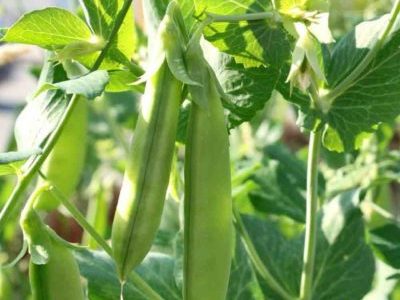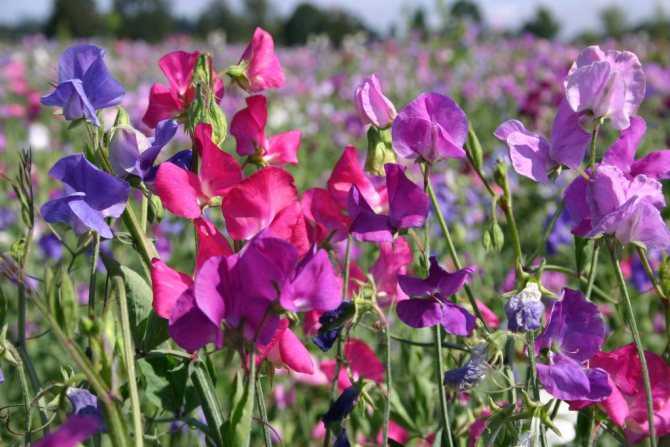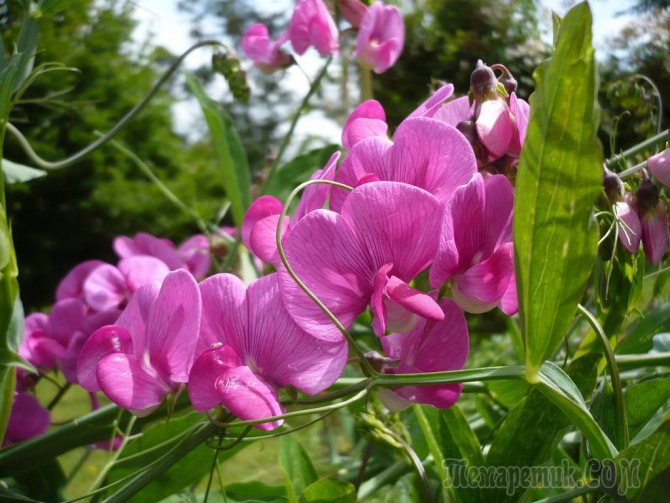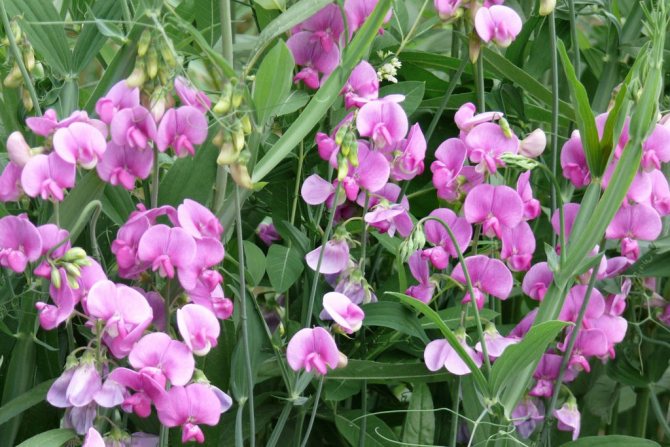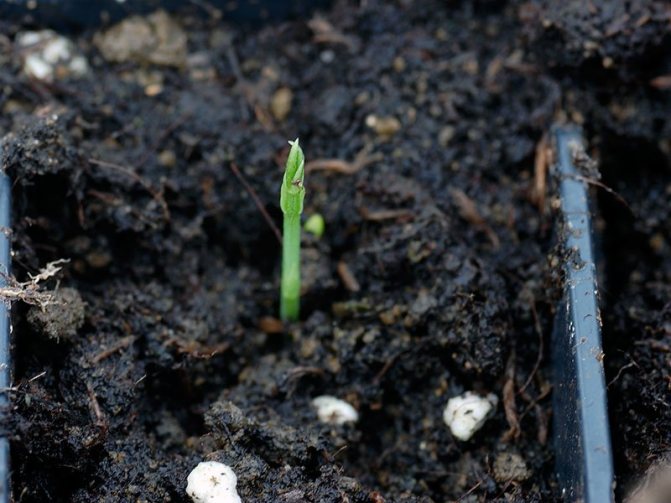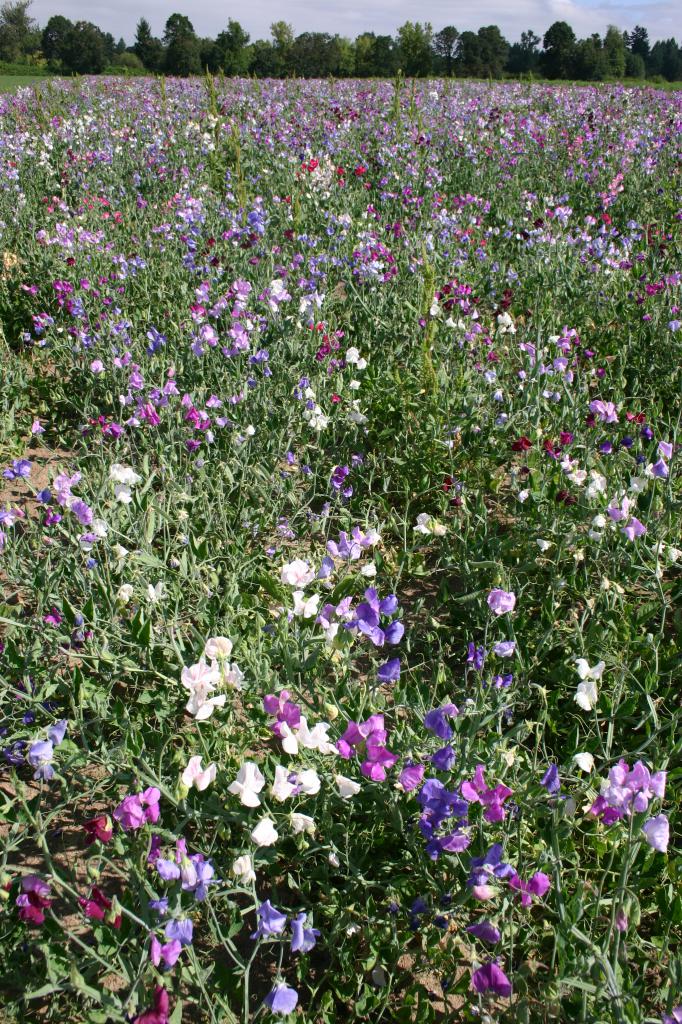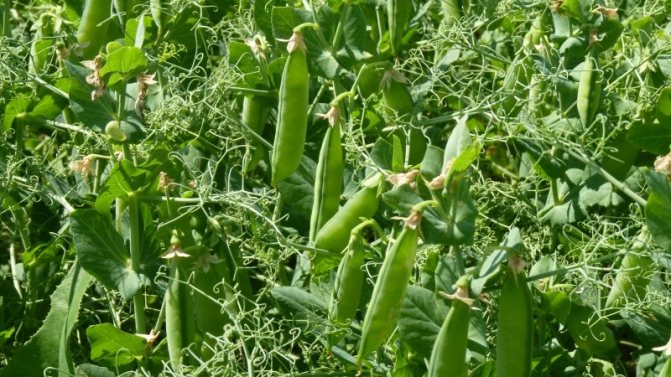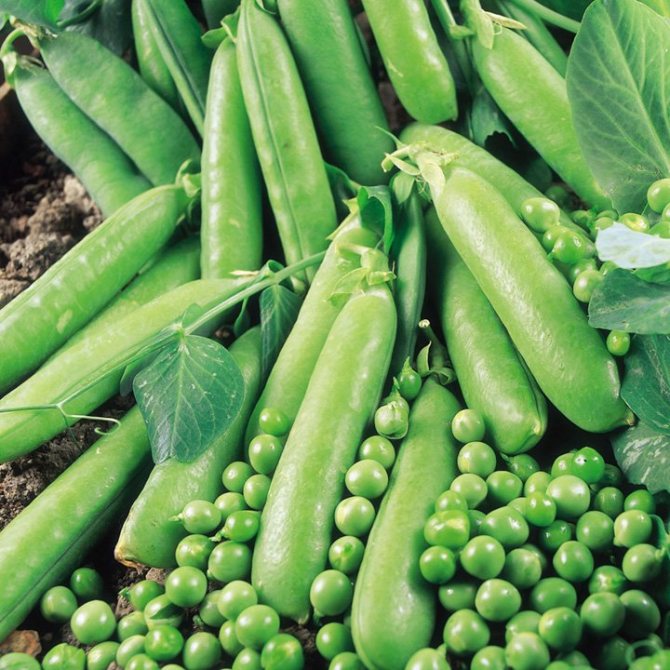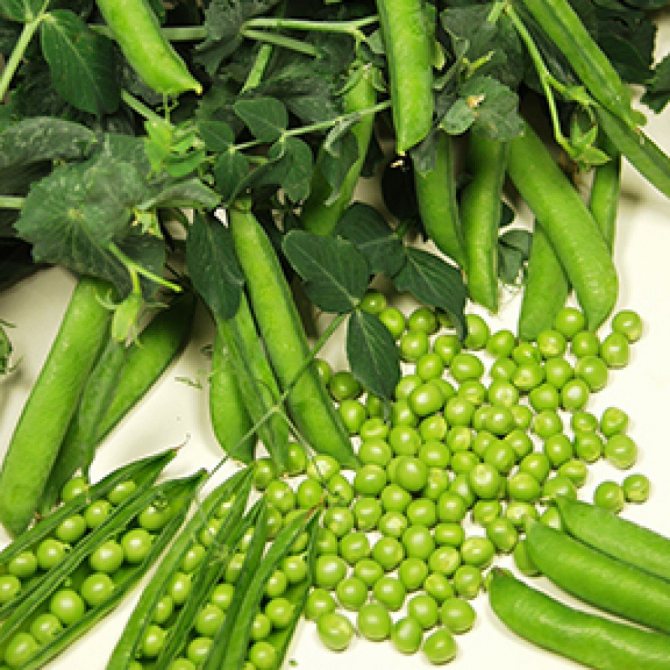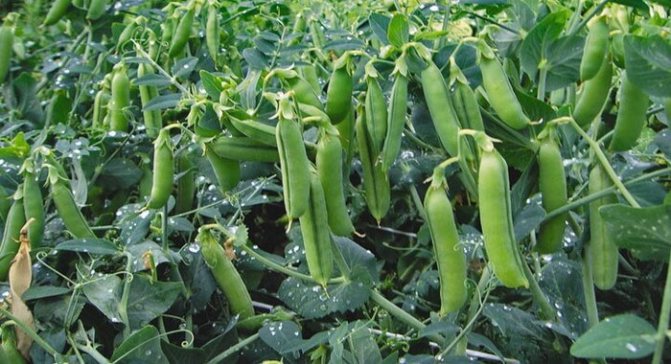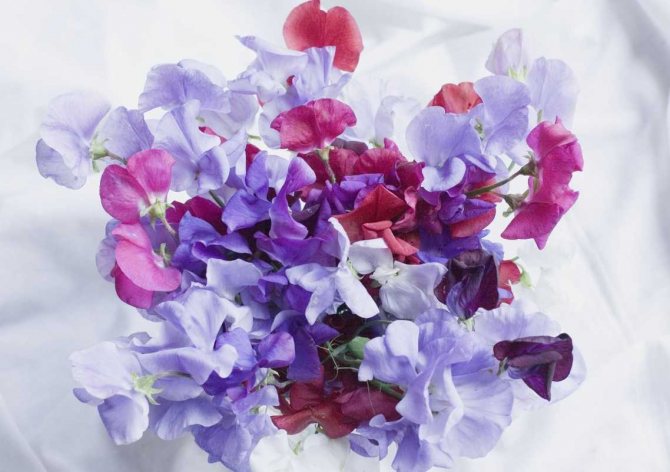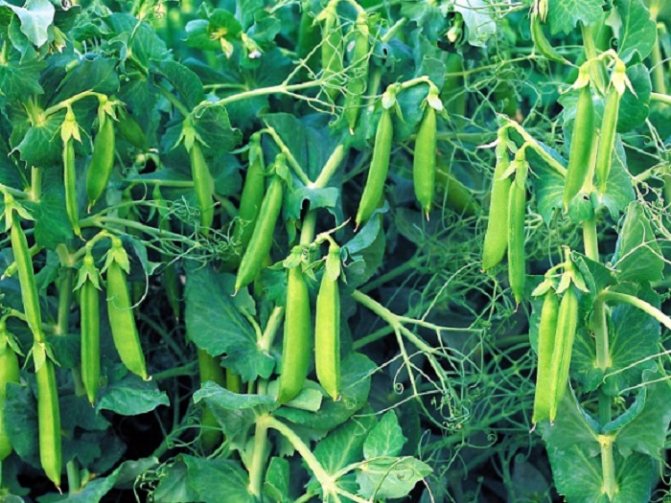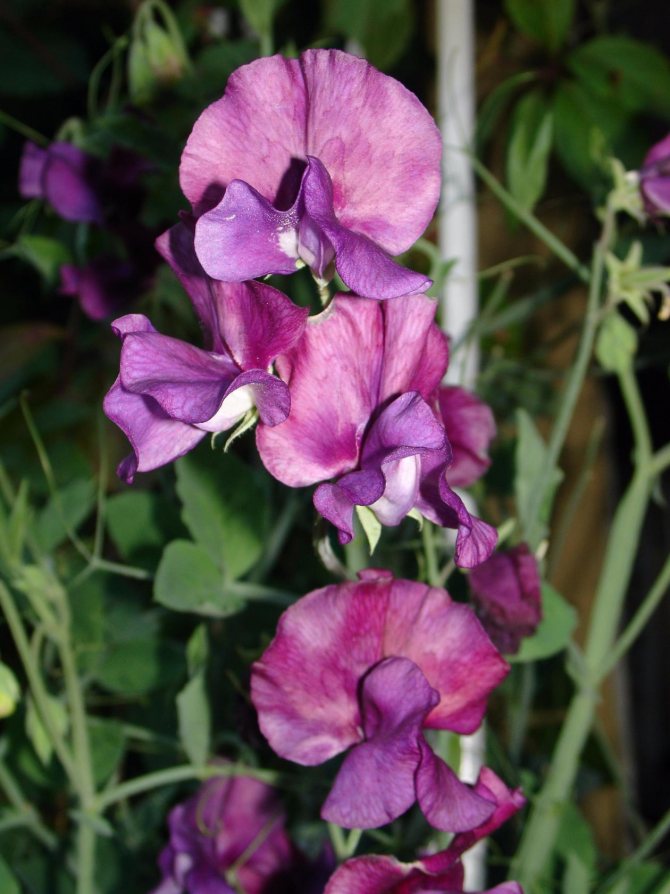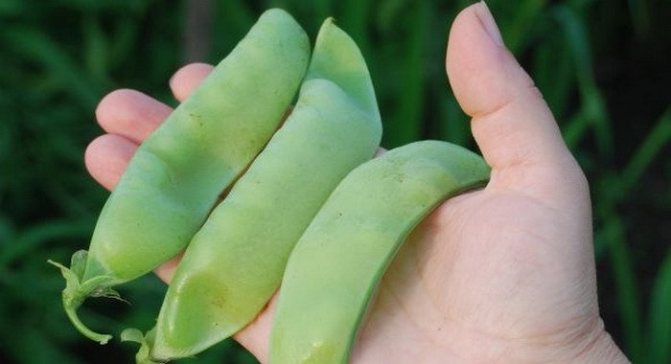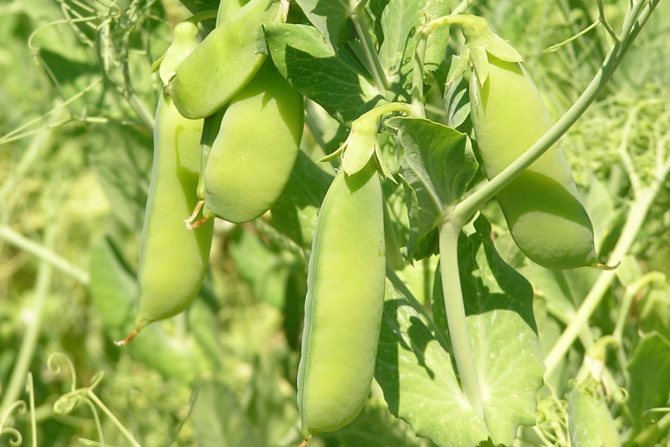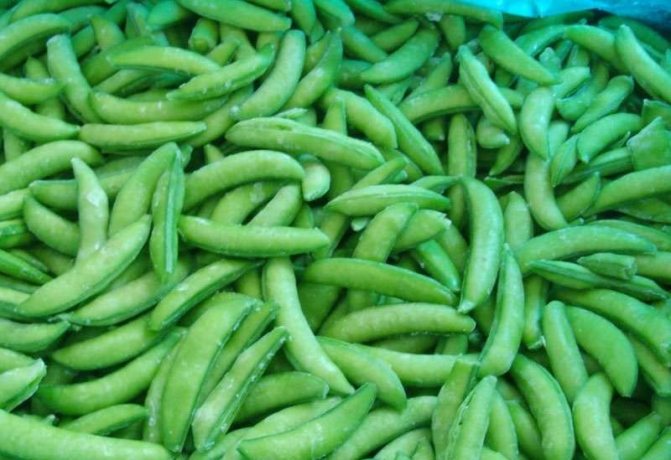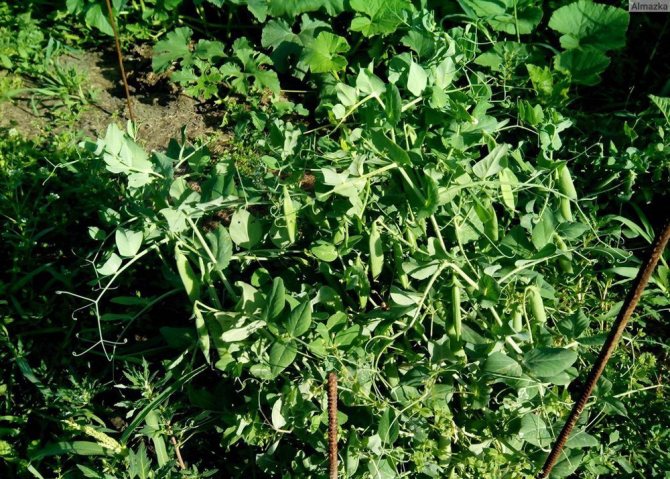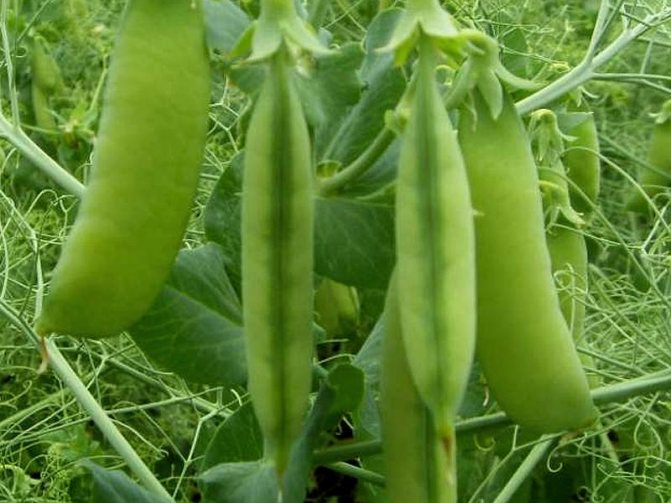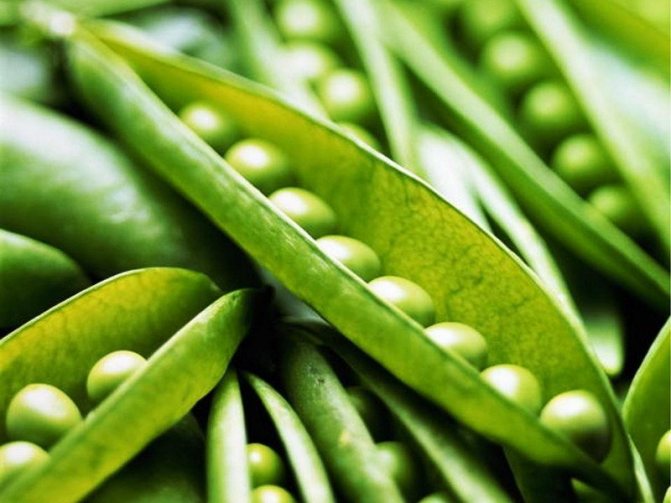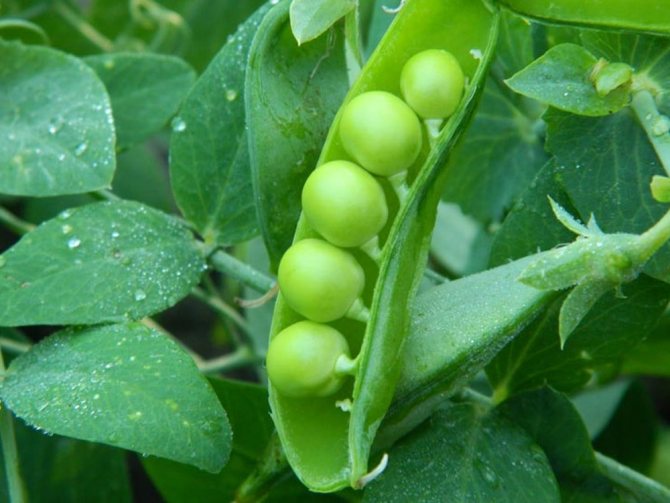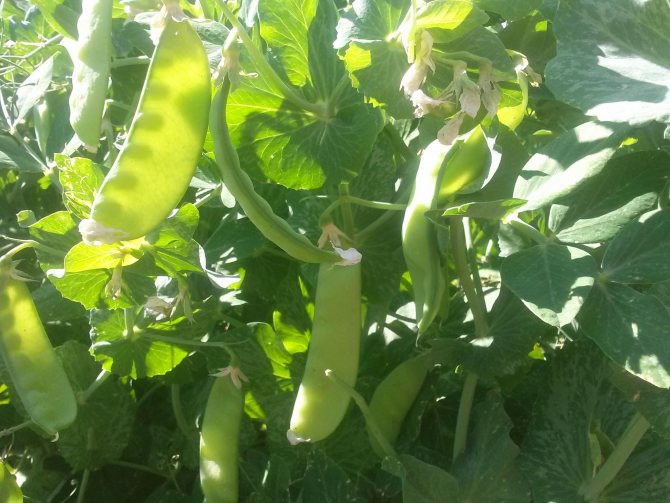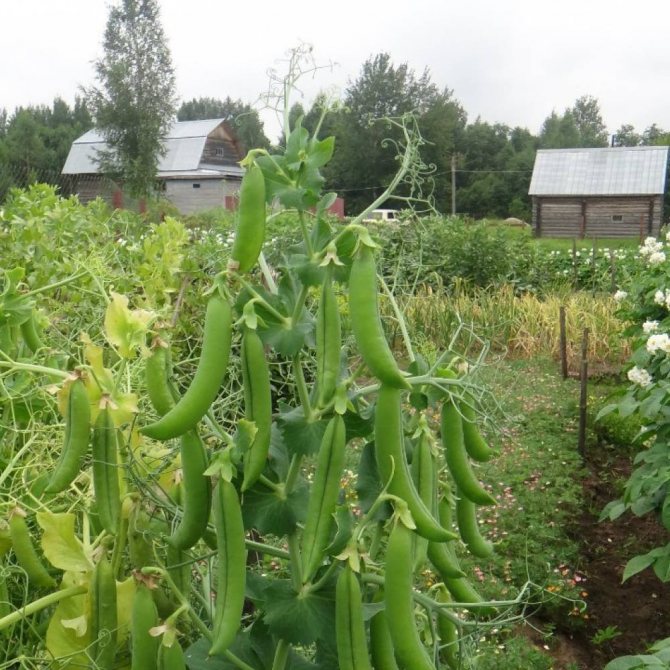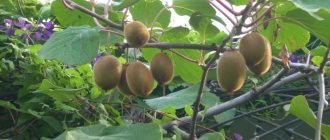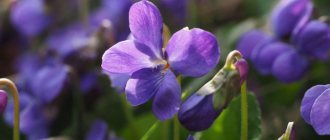Sweet peas are considered one of the most original ornamental plants. Caring for it is quite difficult, and therefore not everyone knows what kind of flower it is. It should not be confused, for example, with a product such as peas.
And although the latter is the seeds of the same "climbing" plant as sweet peas, they are not the same species. An ornamental plant is grown to decorate and decorate gazebos, verandas and mesh fences.
Depending on the variety, the height of the pea stem can vary from 50 to 200 cm. In our country, it is the tall varieties that are more often used. growing from seeds of which is quite affordable, prefers sunny, protected from strong winds. In this case, the presence of a shadow is practically not allowed.
The seedling method of breeding this plant is considered more preferable. The fact is that it has a fairly long vegetative period. Fragrant from the seeds of which in the open field you can start from the end of May, in this case it will bloom only in August. He is not afraid of frost and can easily endure a cold snap down to -5 degrees Celsius.
With the seedling method, you can start acting from the first of April. In both the first and second cases, seeds (2 pieces each) are introduced into a hole about two centimeters deep. These plants do not like tightness as well as acidic soil. In this case, they will grow very slowly. Poorly tolerates peas and transplant. After moving to open ground, it gets sick for a long time and stops growing for two weeks. However, in any case, you can get blooming sweet peas already in early or mid-July. Growing from seeds by planting directly in open ground, as mentioned above, allows you to get flowers only at the end of summer.
In any case, this plant requires high-quality air and water-permeable soil. Otherwise, the bushes may even die. Adult flowers are planted in such a way that there are no more than four plants per 1 m 2. Perennial sweet peas are recommended to be grown in one place for no more than four years in a row. This is due to the fact that spores of a pathogenic fungus accumulate in the soil, which is very dangerous for the health of flowers. For the same reason, the plant is not fertilized with fresh organic fertilizers.
Feed
Its before flowering with urea or rotted chicken manure. In the fall, preparing the beds, humus is introduced into the soil. Sweet peas, growing from seeds and by seedling which is a rather difficult task, are watered not under a bush, but at a distance of twenty centimeters so as not to compact the soil. Loosening is necessary after each watering.
Supports for this climbing plant are placed fourteen days after the first shoots appear. As the stems grow, they are directed in such a way that a beautiful, continuous fragrant "wall" is obtained. Each variety of peas smells differently, but they all look extraordinarily impressive. Its flowers are often compared to multi-colored butterflies. They look very interesting. For bouquets, flower stalks are taken with a length of 25 cm.
– a perennial plant that can delight the eye for a long time, unpretentious in planting and caring. Various varieties of sweet peas will play with bright colors of all colors of the rainbow.
Sweet peas in the garden will be fragrant and decorate until the onset of hard frosts. If you have unattractive hedges, polka dots will help you quickly close that gap.
Looks great when decorating houses, gazebos, green corridors. Planting a plant and getting results is not that difficult. Peas are not at all whimsical to the climate, but there are some points worth paying attention to, about them below in the article.
Is it possible to grow sweet peas from seeds
Growing from seeds is a natural breeding method for sweet peas. There are two options here:
- growing seedlings
- planting seeds in open ground
The first method is quite time consuming. Experts say that it is undesirable to grow seedlings of peas.
Firstly, there is little light on the windowsill and young shoots will stretch out strongly. Secondly, there will be difficulties with planting seedlings in the ground. The fact is that sweet peas have a powerful root system and when transplanting, you need to try not to break an earthen lump. Otherwise, the roots may be damaged and the plant will die.
It should also be noted that the stems of young plants are very fragile. You run the risk of breaking it when transplanting.
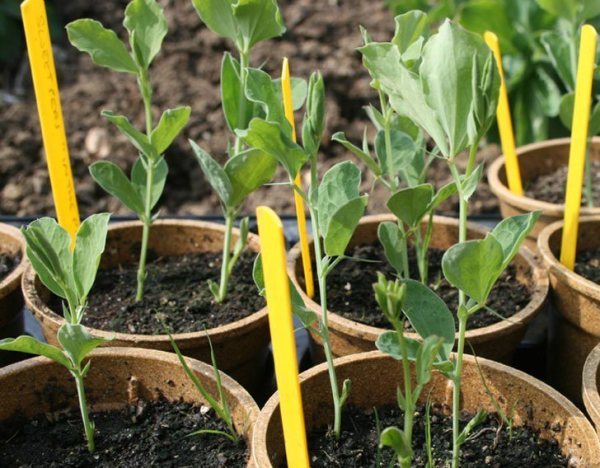
Sweet pea seedlings
The second method also has its own nuances. Flower seeds have good germination. At the same time, their shell is too strong. Germination takes a long time, and they sprout unevenly.
Root rot in sweet peas. What is this disease and how to deal with it?
Root rot is a fungal disease of sweet pea that spreads to the root system. There are a number of chemicals available to combat this disease.
Trichodermin is considered in demand. This is a modern biological agent for the plants of the summer cottage. Discor, which is odorless and not harmful to humans and animals, is also used in the fight against fungus.
Vitaros is used to process seed before planting. Among the fourteen types of domestic medicines that can be purchased in specialized stores, the burgundy mixture is considered the most highly effective in the fight against root rot.
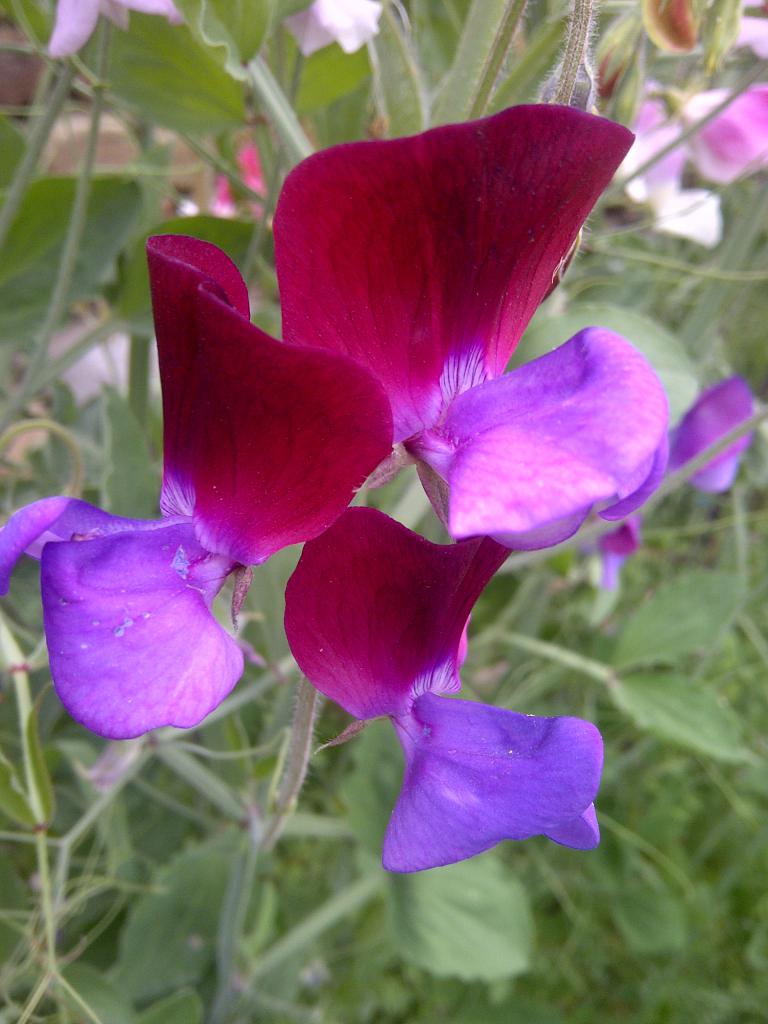

Timing for landing
When to plant annual sweet peas depends on the climatic conditions in your area as well as the type of plant. Different species have different frost resistance.
The very moment of disembarkation should not be postponed. The growing season for this flower is long - about two to three months. Therefore, the sooner you plant sweet peas, the sooner they will delight you with abundant flowering and a unique aroma.
In the mild climate of the subtropics, you can plant the plant in the ground in November. In temperate climates, it is best to plant sweet peas in early spring.
In the conditions of harsh Russian winters, the planting dates are shifted to February. Only you need to plant not in open ground, but in the form of seedlings. After the snow melts, the seedlings should be planted in a permanent place. In open ground, seeds are sown in late April and early May.
Where to plant a flower?
Sweet peas, the planting of which will not cause a lot of trouble for the gardener, can be placed in any corner of the site. Tall varieties are suitable for zoning, design of recreation sites. It is easy to decorate gazebos, benches, playgrounds, summer kitchens with curly vines. They can hide not too beautiful walls of outbuildings, decorate a porch or lattice fence. Long stems are great for landscaping verandas, loggias and balconies. Sweet peas and growing them from seeds is a very interesting topic. Seedlings mixed into the ground take root faster, flowering will be more abundant.
When sowing or transplanting tall varieties, it is necessary to provide for the presence of supports. For flexible vines, wooden, plastic or metal lattices, rope trellises are suitable.With the help of tendrils, the plant can cling to tree trunks, so vines can be planted next to dead wood or tall stumps that need to be masked. Flowers grow very quickly and completely entwine any support in 1-2 months.
Medium-sized varieties are ideal for decorating flower beds, ridges, they can be planted along the paths. Decorative polka dots go well with other crops, and the variety of colors allows you to choose the right solution for any composition. Dwarf forms can serve as a festive backdrop for taller plants. They are placed in pots and flowerpots, used to decorate rockeries and alpine slides. The containers with the plant can be placed on an open veranda, they will fill the air with a delicate sweet aroma, especially pleasant on a hot summer day.
How to plant correctly
Soil preparation
If you decide to grow sweet peas using seedlings, you will need to prepare the soil for planting in advance. To do this, even in the fall, you need to prepare garden land.
It is better to do this before the first frost. Store the excavated soil on a balcony or other cold place throughout the winter.
Mix it with peat seedling soil before planting seeds. After that, it remains to fill the boxes or cups with the resulting soil, water abundantly and put on a warm windowsill. You can start preparing the seeds.
Seed preparation
Experienced gardeners prefer to prepare seeds in several ways:
- the seeds are gently rubbed between layers of sandpaper to loosen their natural shell
- cut the surface of the seed with small scissors to facilitate its emergence
- soak them before planting
To soak the seeds, each variety of sweet peas is placed in a separate container, after which they are poured with hot water. The water temperature should not exceed 60 degrees.
After a day, the water is drained, the seeds are covered with a damp cloth or cotton pad on top. With regular moistening of the napkin, shoots appear in 5-10 days. The seeds can now be planted.
Bedding
Depending on the method of planting the plant, you need to plant either seedlings or germinated seeds in the ground.
The advantage of planting peas seedlings is its early flowering.
When the weather is favorable without frost, the seedlings of sweet peas can be planted in the ground by transshipment. So that the earth does not crumble from the roots of the plant, the seedlings are watered abundantly and the walls of the cup are cut in order to successfully extract the root system along with the earthen clod.
At the landing site, recesses are made at a distance of at least 30 cm from each other. The seedlings are placed in these recesses, covering them with earth and compacting the surface.
When planting sweet pea seeds directly into the ground, they act as follows. After the snow melts, if the ground has warmed up enough, the seeds are sown in 2-3 pieces immediately into the ground.
Depressions of 2-3 cm are made in the ground at a distance of 15-20 cm from each other. Cooked germinated plant seeds are planted in them.
How to deal with powdery mildew
Those who are interested in sweet peas and caring for them should familiarize themselves with the diseases of this plant, as well as with ways to deal with them. Powdery mildew appears on the leaves of young plants in the form of a whitish-gray bloom, which eventually turns gray-brown. There are several folk remedies for controlling powdery mildew:
- Dissolve five grams of laundry soap and baking soda in one liter of water. Spray the infected areas with this solution twice, with an interval of six days.
- In boiling water, add 0.5 cups of wood ash. After two days, add the prepared solution of five grams of laundry soap and a small amount of water to this mixture, mix the solution thoroughly before use.If the plant is severely damaged by powdery mildew, then it should be processed several times, with a break of five to six days.
- A simpler and rather effective way is the use of various weeds. To do this, fill half a bucket with various finely chopped weeds and pour hot water over them. The prepared mixture should be in the process of fermentation for several days, after which it should be filtered through cheesecloth or other filter material. Treat the affected sweet pea plants in the evening.
Plant care rules after planting
For intensive growth and lush flowering, after planting a plant in the ground, it is necessary to provide it with proper care.
This primarily concerns watering. Sweet peas love water, but do not tolerate waterlogging and stagnant water. Watering is recommended to be plentiful, but not too frequent. Enough 1-2 times a week.
Read also: Identification of animals and their registration in farms - Technology of milk and beef production
Usually, three dressings are made for this flower.
- After the appearance of the first shoots with a complex mineral fertilizer.
- At the beginning of budding, fertilizing is necessary, for example, Agricola.
- During flowering fertilizer for flowering plants.


Agricola at the beginning of the budding of sweet peas
To adapt seedlings when planting seedlings, young plants should be shaded for several days. Then provide access to sunlight for at least 5-6 hours a day.
Young shoots need a garter. It is recommended to use twine or net as a support. With a garter, you can control the direction of plant growth and direct it in the right direction.
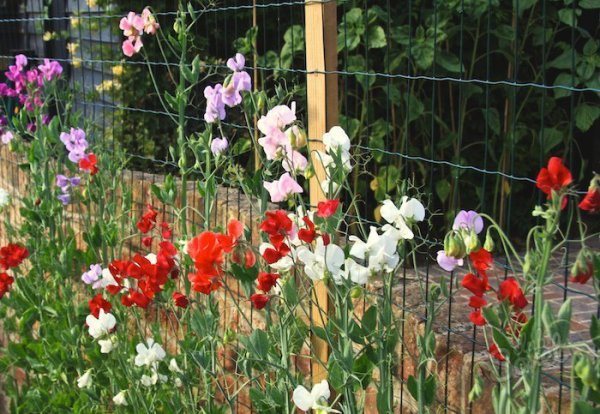

Sweet pea garter
Varieties
- Spencer... This variety was bred by breeders in England. They are tall and multi-stem plants. Terry flowers sometimes reach up to 50 mm in diameter.
- Galaxy... The plant is tall and vigorous, with large and beautiful flowers. Flowering starts quite late.
- Multiflera Giant... This species sometimes reaches a height of up to 1.5 meters. Unlike other species, it has a small number of stems, on which up to a dozen large flowers grow.
- Bijou... Relatively short and multi-stemmed plant with 5-6 large flowers. Mostly used as curbs.
Do I need to trim
Pruning of branches is not required for this plant, as it is curly with flexible stems that lend themselves to the direction of growth. But for a lush flowering, it is necessary to remove faded buds in time. This will ensure longer flowering until late fall.
At the end of flowering, before winter, the plant is cut to the root and covered with sawdust for insulation. Growing sweet peas is not as laborious as it might seem at first glance. A little care and maintenance is enough for the abundant and fragrant flowering of this plant.
Useful properties of fragrant ranks
In modern medicine, the plant is not used for the treatment and prevention of diseases, but in folk medicine, sweet peas are used for colds and raising immunity.
A decoction from the tubers of this culture is taken for diseases of the gastrointestinal tract, cardiovascular system. The liquid dosage form also helps with sleep disorders (insomnia).


Learning how to grow sweet peas - a fragrant ampelous plant
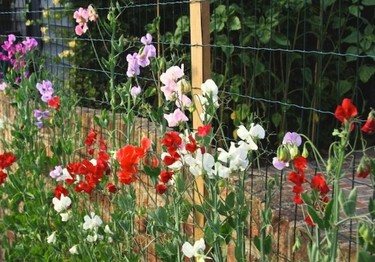

Sweet peas are rightfully considered one of the most favorite ampelous garden plants. Its long curly lashes can often be seen not only on gazebos and arches, but also on city balconies. This plant is really incredibly attractive: possessing the ability to curl along a support and braid it, it also blooms gorgeous. Large inflorescences, similar to a sailing boat, bloom in the middle of summer and delight until frost. They can have different colors, moreover, they emit a pleasant aroma.Therefore, many gardeners are interested in how to grow sweet peas, because it is a wonderful crop for vertical gardening. Today we will tell you when and in what way it is better to plant it. We will also find out the basics of caring for peas growing in the garden.
Variety selection
Sweet pea perennial or rank is a fast-growing herb from the legume family. The stem is thin and flexible, reaching 3 m in length. Ampel species are attached to the support with antennae; more compact versions do not need support. Inflorescences, distinguished by their richness of shades, deserve special attention. Butterfly-shaped buds have smooth or corrugated petals; breeders have also bred terry varieties. Flowers are collected in pairs or small clusters. There are options for snow-white, pink, cream, purple, bright red or cherry tones. The buds have a delicate sweetish almond aroma that attracts pollinating insects.
There are about 1000 known varieties of peas, all of them are divided into groups. The easiest way to classify plants is by stem length.
- 1 Tall. This category includes varieties up to 3 m in length. Strong flower stalks up to 35 cm high are intended for cutting, they are also suitable for landscaping the site.
- 2 Medium-sized. Members of the group are more compact and do not need support. Stem length 60-90 cm, flowers are large, double, with a pleasant delicate aroma.
- 3 Miniature. The group unites short plants with strong stems 15-45 cm long. Ideal for decorating flower beds, go well with other summer plants.
There are varieties in each category that are worth paying special attention to. When choosing seeds, it is worth considering that many varieties of foreign selection have a low germination capacity and pick up buds later than domestic counterparts. For planting in the ground, it is recommended to pay special attention to Russian varieties, which are characterized by rapid growth and abundant flowering.
Alice. Tall liana with elegant pink-cream flowers, collected in graceful brushes. Suitable for vertical gardening, the buds bloom in late spring and have a pleasant, persistent scent.
Teremziy. Liana up to 3 m long, strewn with medium-sized, very fragrant white-pink flowers, collected in pairs.
Selektsvet. Unusual option with cherry red buds. The stems are long and strong, they are characterized by very fast growth and good green mass gain.
Cremona. A graceful plant with creamy fragrant flowers, collected in bunches of 5-7 pieces. Slightly corrugated petals look very nice in bouquets.
Lummar. Medium-sized variety with large white-pink buds. Differs in especially lush flowering, good in a flower bed and in a cut.
Galina. A miniature version with a spectacular purple-lilac color. It is ideally combined with varieties of white, cream and pink shades, it has a very pleasant rich aroma.
Argyrine. This unique dwarf variety can be grown in flower beds or in pots. Flowers are white-pink, fragrant, terry.
Landing features
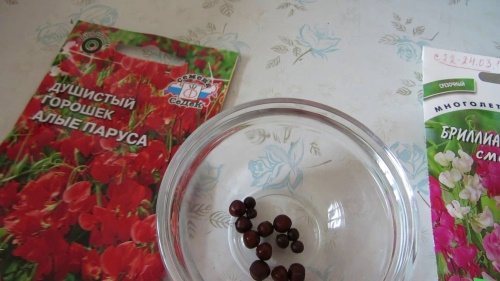

Sweet peas are perennial in nature, but in our climate it grows as an annual crop. Delicate sprout lianas cannot survive outdoors in the Russian winter. The seedling method is considered the preferred method of growing peas for several reasons:
- Seeds (beans) sprout for a long time, reluctantly and unevenly. When planting directly on a flower bed, it often turns out that half of the garden bed is empty.
- The plant has a long growing season and blooms no earlier than 2 or even 3 months after sowing (in July).
In order to have time to admire and enjoy the full flowering of an annual plant, it is better to grow it through seedlings. In this case, the peas can bloom as early as late spring.
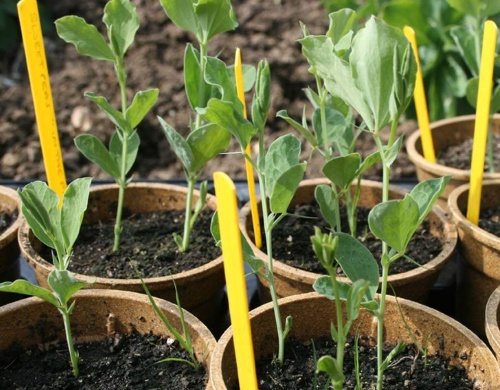

Seeds can be planted on seedlings at any time, even in late autumn - it all depends on the goals and the region of cultivation. But if peas are planned to be planted outside, it is better to do this not earlier than March.
Sweet pea seeds need preliminary preparation. First, they are soaked in warm water with the addition of a growth stimulant, and then germinated.
Sprouted beans are recommended to be planted immediately in separate cups, you can plant a couple of them. This will avoid diving, in which fragile stems often break. Before germination, crops should be kept in a warm and bright place, under a film. When the peas release sprouts, the film is removed and the pots are moved to a cooler place (no more than 16 ° C heat). It is also advisable to install additional lighting so that the seedlings do not stretch out.
After the formation of a pair of true leaves, you need to pinch the top of the central and lateral (if any) shoots. So the bush will be more lush. In open ground, seedlings can be planted no earlier than return frosts.
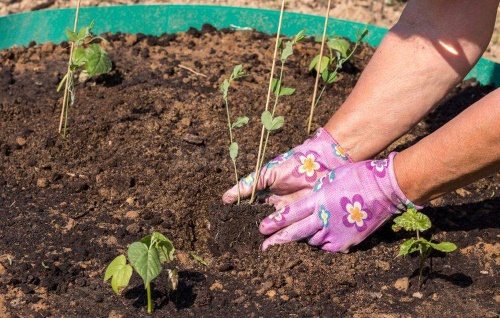

Seed reproduction
Propagated by seeds (1 g contains 8-15 pcs.). Sowing seedlings in February-March, in separate containers.
Sweet pea seeds
In the south, you can immediately sow in open ground: dry, without soaking - in March-April, with soaking - in May.
Summer residents in other regions will have to grow seedlings. Before sowing, the seeds are soaked in hot water, left in it for 10 hours, then kept in sawdust for 3-4 days at a temperature of +18. + 20 ° C for germination. The nashed seeds are sown in peat pots. The soil substrate consists of a mixture of peat, humus, sod land and sand (2: 2: 2: 1), the embedding depth is 2 cm.
Sweet pea seedlings
In May, the seedlings of sweet peas are carefully transferred into the open ground.
Practical advice: do not store sweet pea seeds for a long time: their germination capacity lasts from 2 to 5 years.
You will find an extensive selection of sweet pea seeds in our planting material catalog, which includes offers from large garden online stores. View a selection of sweet peas:
How to grow sweet peas: plant care outdoors
A place for planting a plant should be chosen warm and sunny, with fertile and loose soil. On poor soil, it is advisable to add compost and a mineral complex based on phosphorus and potassium into the holes during planting. If the peas are tall, then they are either immediately planted near an arch or arbor, or a separate support is installed for each plant. You can also stretch a common net along the garden bed. As the shoots grow, they will need to be guided and tied up at first until they attach with antennae.
Low-growing varieties of sweet peas do not need support.


It is not necessary to water the plants often, but abundantly. The main thing is that the earth does not dry out, otherwise he will drop flowers. By the way, in order to prolong flowering as much as possible, wilted flowers are plucked, preventing them from tying pods. For the same purpose, the bushes are fed with fertilizers for flowering plants, although peas are able to grow without them.
Read also: Tincture of cinquefoil from what helps, how to take for joints
Video about the secrets of growing sweet peas
Accommodation in the country
The rich amplitude of the height, all kinds of flowers (except for yellow) and a wonderful delicate aroma are the indisputable advantages of sweet pea. They make it possible to use this plant in a wide variety of garden design elements. Low-growing or dwarf varieties can be planted as a flower border, in the foreground of landscape flower beds, and even in rockeries. They look luxurious in various flowerpots.
Dwarf sweet pea in a container. Photo from the site. Among the stones. Photo from the site amazon.co.uk Tall varieties are ideal for vertical gardening, creating accents in flower beds on various types of supports.
Sweet peas (tall varieties) ideal for vertical landscaping
It looks luxurious both on forged trellises and on simple supports.
Sweet pea looks great on a simple prop
Sweet peas are truly a royal flower! Even on village fences, it looks respectable.
Sweet peas look great on the simplest fence
Practical advice: To fully enjoy the delicate aroma of sweet peas, it must be planted at face level. It is luxurious both as an ampelous and as a climbing container plant.
Sweet peas can be grown in containers and balcony boxes. In addition, it can be used to decorate a balcony or loggia, shade a gazebo, and create a hedge.
Sweet peas can be cut to create beautiful, fragrant bouquets, including wedding bouquets (based on pastel varieties).
Sweet pea bouquet
If you update the cut of the stems every day and change the water in the vase, then the bouquet will last more than a week!
And in conclusion - the traditional questions from the author. Do sweet peas grow in your country house? Which varieties do you like the most?
Why grow sweet peas?
Sweet peas, beautifully braiding the supports, have a lot of advantages, thanks to which they have gained a lot of admirers among summer residents - they can often be found in garden plots. This culture is unpretentious, perfect for landscaping loggias and balconies - it is enough just to grow it in ordinary boxes.


Sweet peas will adorn any area
The important advantages of this culture include:
- Excellent decorative properties. So, with the help of sweet peas, you can very quickly make a flowering screen on the site, cover up ugly places on the wall of a house or other building, decorate a gazebo.
- Unpretentiousness. This plant perfectly tolerates frosts down to -5 degrees.
- Thanks to the peas that braid the supports, you can create a small and pleasant partial shade for relaxation on the site.
- When planting low-growing crops, you can not waste time creating supports.
- Long bloom. So, peas can bloom for at least three months, while the gardener does not have to make serious efforts to this.
- High growth rate compared to other types of vines.
- Sweet peas can be grown not only outdoors, but also in a box on the balcony of the house.
- When cut, this plant can be stored for a long time, and excellent bouquets are obtained from its flowers.
The history of the fragrant rank
Before moving on to the topic of caring for and planting sweet perennial peas, we will take a little look at the history of the plant. Its thickets can be found throughout Europe, South America, and some species - on the slopes of the African mountains. They are fragrant gifts from nature. These plants, which reach a height of two meters, are bred mainly to decorate the backyard.
The name of the plant in Latin is "latirus odoratus". "Odoratus" translates as "smell inhalation", and the word "latirus" was first used by the ancient Greek founder of botany Theophrastus and consists of two words: la - "very" and thoures - "attractive".
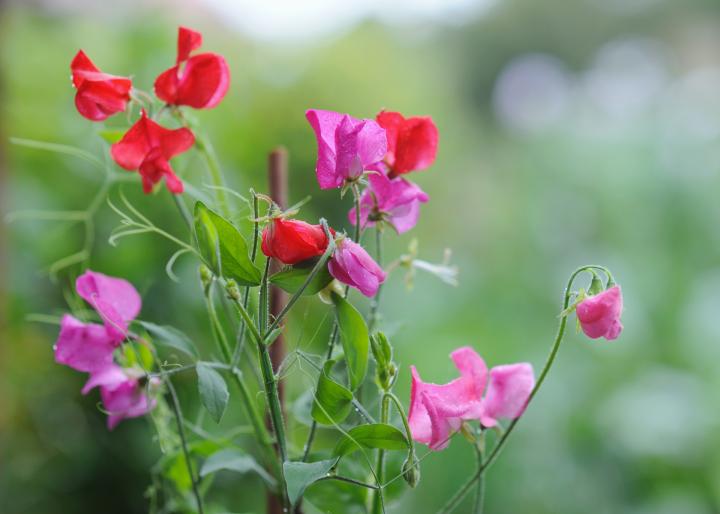

There is an official version of the origin of this culture, which says that the English minister of religion, Francisco Kupani, more than three hundred years ago, walking near the walls of his monastery, located on the shores of the Mediterranean Sea, caught the pleasant smell of a plant unfamiliar to him. Kupani collected the seeds and sent them in 1699 to England to his friend Robert Uvedal, who gave the package to the collectors. Many botanists have a different version. They say that perennial sweet peas are native to Peru and Ecuador (states of South America).
At that time, many European sailors visited the shores of these states, and, probably, the plant in its original form was brought earlier by them to Malta, which at that time was an English colony. After some time, this plant came to England and thanks to English breeders in 1800, the first five varieties of this flower appeared, which had only blue and pink colors.
In Russia, in 1938, the Gribovskaya Experimental Breeding Station received several varieties of pea seeds from the English one, and a group of breeders led by Irina Dryagina, Doctor of Agricultural Sciences, began to study this crop. 52 years later, the first twenty varieties of domestic sweet peas appeared.
Perennial sweet peas, clinging to various supports with their antennae, adorn the walls of balcony loggias and summer cottages. This is probably why the plant is popular among flower growers.
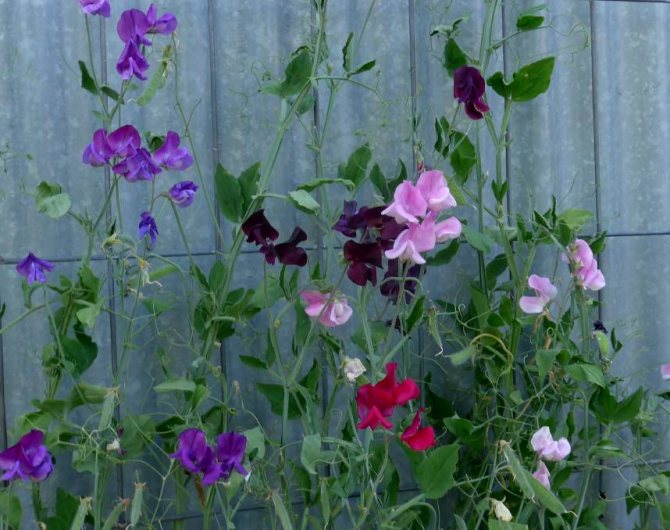

The reason for the demand for the cultivation of this type of plant lies in the fact that pea flowers can tolerate spring and autumn frosts. Compared to other crops, which tend to twine around any support, the fragrant rank grows faster and has a long flowering period. Bouquets of flowers of different shades retain their freshness, smell and attractiveness for a long time. Some plant varieties (undersized) are used for flower beds.
What conditions should be created for growing a crop?
This culture grows well in a variety of climatic zones. For example, it feels great in calm and open areas (the main thing is not to plant it in the shade), in slightly moist and drained soil.
This culture will develop poorly on clay and heavy soils, in addition, regular waterlogging of the soil or too close the occurrence of groundwater to the surface of the soil can adversely affect the plant - its petals begin to fall off, and the peas die.
Also keep in mind that nitrogen supplements or fresh manure should not be used on this plant. It is best to choose a soil with a neutral Ph level for the development of sweet peas. If the land has an increased level of acidity, it is necessary to carry out liming with the use of slaked lime before planting the crop.
Description of the flower with photo
For the first time, it was in 1696 in Italy, sweet peas were discovered by the botanist Kupani. From there it was brought to England, and for 300 years of selection, specialists managed to bring out more than 1000 varieties of fragrant ranks.
The peculiarity of the pea is that its strong shoots can reach two or more meters. Deftly clinging to the supports with antennae, the stems stretch upward, creating a picturesque vertical carpet. The flowers of the peas are collected in inflorescences, which bloom one after the other, and this makes the flowering permanent.
The flower itself is very similar to a sailing boat with oars. By the way, individually, parts of the flower are called exactly that: sail, oars, boat.
However, the liana-like plant has dwarf forms, the height of which is about 30 cm.This flower does not need support.
Sweet peas bloom two months after germination and continues to delight the gardener with the brightness of the inflorescences throughout the warm season.
After the petals wilt, a fruit is formed, which is a bivalve bean. It contains up to 10 peas of beige or dark brown color. If you leave the first pods on the plant, then they will have time to ripen, and this will make it possible to get your own seeds.
In garden culture, sweet peas are presented in two types, it can be grown in an annual culture, and there are perennial varieties. Both are grown from seed and produce strong, ribbed shoots. The ability to cling to anything that gets in the way requires an obligatory support. Therefore, planting a flower should be done:
- next to walls that you want to give a decorative look.
- along fences that will look like a hedge.
- tall shoots of fragrant ranks will hide an open arbor from the hot rays of the sun.
Perennial sweet peas are not rich in colors. Most often these are pink or purple flowers, collected in a brush. Many strong lashes reach two meters and require a strong mesh support for the plant to grow and develop freely.
The one-year-old rank has a much more interesting color palette. Flowers of this species can be white and blue, pink red, burgundy and blue. Annuals give off a more delicate aroma than perennials.
Sweet peas bloom from June until the onset of cold weather. Prefers open, sunny places with fertile soil and neutral reaction to acidity.
Lodging of the stems should not be allowed - this leads to their defeat by diseases and decay.
Group of varieties "Spencer"
Variety "Sir Charles"
All types of fragrant ranks are divided, in turn, into groups. Among the tall varieties, the Spencer group can be distinguished. It is a multi-stemmed plant with a shoot length close to 2.5 m. Peduncles are strong and consist of 3-5 flowers. The petal itself, or as it is called, the sail, has a wavy top edge.
- The variety "Aristocrat" has a deep sweetish aroma, which exude charming white-pink flowers
- "Sir Arthur" will decorate the garden with soft lilac sails
- Sir Charles is scarlet.
Kazberston
The varieties included in the Kazberston group are distinguished by their multi-flowered nature. There are up to 8 of them in the brush. The stems of the plant are long, which makes it popular in garden design. Plus, it looks amazing in the cut.
On a note. It should be remembered that sweet pea bouquets are best formed after all the buds in the brush have bloomed. This is due to the property of the flower "not to unfold the sails" in the cut.
Royal
The Royal group consists of early flowering varieties. They have large flowers, and the color of the upper petal can be delicate (white, pink) or rich (bright red, lavender blue).
Low-growing varieties, they are dwarf, are also divided into groups.
Group "Biju"
"Bijou"
"Biju". Plants of this group are distinguished by large flowers and bright colors. The height of the bush is about 30 cm, abundant flowering.
Group "Pink Cupid"
"Pink Cupid"
Peas from the Pink Cupid group are characterized by a wavy edge of the upper petal. Its color can be white or delicate pastel colors, blue-purple or pale blue, pink or red. The flower does not exceed 30 cm in height.
Flowers from both of the above groups can be used for flower beds, borders and cuttings.
"Fantasy"
"Fantasy" is a group of varieties that have a miniature height. Growing no more than 20 cm, they serve as an ideal edging and are used as a ground cover plant.
Low flowers create bright multi-colored rugs on the site and fill the air with a subtle scent of beauty.
A fragrant rank is grown by sowing seeds in open ground or by seedling. For open ground, both spring sowing and before winter are applicable. Due to its cold resistance, the seeds winter safely in the soil, and with the onset of heat they begin to germinate.
Sowing before winter
Sowing in winter has a number of advantages over growing a flower through seedlings. First of all, this lies in their viability:
- seedlings from autumn crops are not afraid of spring temperature drops
- they are more adaptable to transplant stress
- are distinguished by lush flowering throughout the summer season
Autumn sowing is carried out with the onset of frost, but the soil must be ready at least 2 weeks before that. It is well loosened, weed roots are selected and leveled. On the finished bed, grooves are cut to a depth of 5 cm. Seeds are laid out in them at a distance of 3-5 cm, covered with dry earth and well compacted. In spring, seedlings will appear with the onset of stable heat.
At the same time, seeds sown in the ground in late April or early May will germinate.The sowing principle is the same, only the seeding depth is reduced (up to 2-3 cm).
However, spring crops require more attention: it is necessary to monitor the moisture content of the soil and in no case should it dry out. It is best to cover the bed with a film, this will prevent evaporation of moisture from the surface and create a greenhouse effect.
Soil moisture and temperature within 20 ° C are the main components of the friendly germination of sweet pea seeds.
Seedlings
To obtain early flowers of fragrant ranks, many summer residents resort to the seedling method of growing. The difficulty lies in the fact that the plant has a long taproot and does not really like to be disturbed.
Therefore, it is preferable to sow in cups, be it peat or plastic. Then the transplant into open ground will take place with less trauma to the root system.
In the first case, the plant practically does not feel the moment of transplantation. And from a plastic container, a bush of sweet peas is transferred into the hole along with a lump of native soil.
Before sowing, the seeds must go through a processing stage. First, they are calibrated and damaged ones are removed.
To determine the fullness, the seeds are immersed in a saline solution. It is prepared from 1 liter of water and 30 g of salt. The part that turned out to be on the surface is removed, and the settled ones will be used for sowing. But first, they must be rinsed from salt and soaked. Soaking is carried out in hot water and lasts a day. This helps to soften the dense shell of the grain.
Further, to obtain a result of 100%, the seeds are germinated by wrapping them in a soft cloth. It should always be damp and in a warm place. At this stage, it is important not to miss the emergence of sprouts.
The peas that have hatched are distributed in cups and covered with foil. After waiting for shoots, the container is moved to a light windowsill. Adequate sunshine will keep the seedlings from pulling out. For greater bushiness, the sprouts are pinched over 3-5 leaves.
All the activities described above also apply to perennial varieties of fragrant ranks.
We plant sweet peas: video
On the 20th of May, the grown bushes of ranks can be fragrantly transferred to the site. If the weather is hot, then the plantings should be shaded - this will save the delicate leaves of the flower from burns.
When preparing a bed for sweet peas, mineral fertilizers are applied and embedded in the soil. The soil should be loose and moisture-permeable, since the root system of the flower goes deep into the depths for a long distance. This requires abundant but infrequent watering.
The location of the fragrant rank is chosen taking into account the illumination and protection from the wind.
- The light-loving plant does not tolerate drafts, but can grow in light partial shade.
- When choosing a site, you should consider the possibility of installing supports for tall varieties.
- As the stems grow, they should be directed in the right direction to create the intended composition.
Loosening and hilling are also necessary measures in the care of flowers. Hilling stimulates the regrowth of adventitious roots. This leads to the emergence of new shoots, therefore, to a more lush flowering.
Timely removal of wilted flowers will help to achieve continuous blooming of buds. Otherwise, the fruit will set in the form of a pod, and the plant will switch to ripening the seeds. If there are many such fruits, then the plant will stop setting new buds. In this case, flowering will end within one month.
But if the grower needs to get his seeds, then a few pods should be left. During this period, it must be remembered that only 5-10 peas are formed in the valves. Therefore, based on your needs, it is easy to calculate the required amount of seed.
The seed pod is formed at the point where the flower meets the stem. This happens after the flower wilts and the petals fall off. Initially, it looks almost flat and has a green color. As the peas grow inside the leaflets, the pod will thicken and change color.At first, it will turn yellow-green, and by the time it ripens, it will turn light brown.
This is the most opportune moment to collect the seeds. The pods are cut or cut from the plant and left to dry for several days in a dry place with sufficient air. Then they are carefully opened and the contents are poured onto a dish with sides. In this form, they should stand for another 2-3 days.
The finished seed is packed in paper bags and stored in a dry place. Pea seeds are able to remain viable for 7-8 years.
Among the diseases of the plant, the most common are powdery mildew (false and true), black leg and brown spot.
To eliminate the signs of powdery mildew, the drug "Topaz" is used. 4 ml of the product is diluted in 10 liters of water and consumed for 8 m2 before and after flowering.
Black leg and brown spot are treated with the "Hom" preparation (10 l of water + 40 g of the product).
Observance of crop rotation, maintenance of cleanliness in the area with flowers, removal and destruction of plant residues play an important role in the prevention and control of diseases. You can return the flower to its original place not earlier than after 3-4 years.
In case of damage by pests (aphids and nodule weevils) use the drug "Fitoverm". 2 ml of the product is added to a liter of water and sprayed with the plantings of sweet peas. This amount should be enough for 10 m2.
With the onset of cold weather, planting perennial peas should be put in order. The stems are removed from the supports and pruned at ground level. The earth is mulched with sawdust or humus. The cold-resistant plant easily tolerates the winter period, and in the spring it begins to germinate as soon as the soil thaws.
Undoubtedly, the fragrant rank requires attention and care. But when it blooms and fills the air with a delicate aroma, all the chores seem insignificant. And the gardener, admiring his creativity, determines the places for planting flowers in the next summer season.
The sweet pea plant appeared through selection. Scottish nursery worker G. Ekforth bred this one-year-old liana by crossing several nondescript, but very fragrant flowers, resulting in an excellent culture, distinguished by its decorativeness and splendid smell. The breeding work did not end there; in subsequent years, many amazing varieties were bred. This is an annual plant with high-climbing stems, 150-200 cm high, has a fast growth, unusually abundant and long flowering, retains the ability to bloom even after the first frost, with a wide variety of colors and a wonderful smell of flowers. As you can see in the photo, sweet pea flowers have delicate shades - from pure white to dark red and from light blue to dark blue:
There are even plants with orange flowers.
The inflorescence is a brush, it can have from 3 to 16 large flowers up to 6 cm in diameter, but no more than 6-7 flowers can bloom at the same time. The length of the peduncle in multi-flowered varieties reaches 50 cm. The long stems of fragrant flowers, the tenderness of their colors have provided this plant with one of the first places among the fragrant flowers that go for cutting. Flowers stay in water for 5-6 days. You will receive detailed information about the agricultural technology of care for the cultivation of sweet peas and about this plant itself in this material.
Some tips for growing sweet peas
Some gardeners believe that growing sweet peas is quite problematic, because this culture is capricious. In fact, this is not so, and if you put into practice our advice, then there will be nothing complicated about it.
To create optimal growing conditions, consider the following tips. For example, some people plant peas as seedlings, but this process is more laborious than growing with seeds. In addition, the seedlings are more capricious, less frost-resistant. It should also be borne in mind that seedlings have a fairly highly branched root system, for which transplants can be destructive.That is why the seedlings will have to be transplanted together with an earthen lump, and it is best to plant them in a peat pot.
Sweet pea seeds are characterized by a dense shell, which makes their growth more difficult. Various methods can be used to speed up the germination process, for example, soaking, scoring, etc.
The planted sweet peas stretch out quickly enough, they can break, therefore you should install a support, and the sooner the better. Start tying the peas as needed.
Pea roots are very long, penetrate deep into the soil, and absorb a lot of moisture. That is why regular and frequent watering is necessary for the normal development of plants.
Disease and pest control
One of the plant pests is the weevil. Its adult eats up the leaves, and the larvae harm the root system of the plant. For preventive control of this pest, before planting, 100 grams of Chlorophos solution is added to the wells. After planting, the seedlings themselves must be treated with the same solution.
Different types of aphids also cause great harm. To destroy them, gardeners use the drugs Tsineb and Tsiram. The processing of peas with these drugs is carried out every 2-3 weeks. The most common disease of this species is powdery mildew. As soon as the leaves begin to turn yellow and fall off, they must be treated with a solution of colloidal sulfur.
Dates of planting sweet peas
Before you start planting, you first need to choose the most suitable variety for growing in your environment. Also, do not delay planting, because this crop has a rather long growing season. From the moment the seeds germinate to the beginning of flowering, it will take an average of 2.5 months. And because the earlier you plant, the sooner the plant will bloom.
But under the condition of a harsh winter, sweet peas can be planted in mid-February, however, not in open ground, but at home. Due to this, you can prepare the seedlings for the beginning of the season. If you live in a region with a temperate climate, then you should soak the seeds in early May if you are planning an autumn planting. But you can plant a crop in open ground from April to June.
Read also: Ahimenes: description of varieties, tips for care and reproduction
The legend about the fragrant rank
We have already talked about leaving and landing. An interesting legend is associated with fragrant perennial peas. It says that the goddess Flora (this is the patroness of flowers), walking through a forest glade, drew attention to the multi-colored butterflies that fluttered around her. One of the most variegated perched on a bush, and her multi-colored wings created the illusion of a living flower against a background of green leaves. Seeing this beauty, Flora decided to revive this bush. So, according to legend, a fragrant rank appeared.
Seed preparation rules - what needs to be done?
There are a number of tricks you can use to speed up seed germination. For example, you can gently wipe the grains with light-grit sandpaper, or scissor the surface with small scissors.
Choose the right seeds for planting
To create optimal conditions for germination, you need to soak the seeds in water for 2-3 hours. True, it should be borne in mind that the grains themselves must be dry when planting.
To germinate sweet peas, place different varieties in a separate container and cover with water (temperature about + 60 degrees). After a day, drain the water and cover the grains with a damp cloth, adding water so that they do not dry out. Some gardeners germinate seeds in wet sawdust or sand.
If the containers are kept at a temperature of about +20 degrees, then in about a week they will germinate. As soon as the seedlings appear, the seeds must be planted immediately.
Seed propagation and growing of seedlings
Perennial sweet peas can be sown directly into the ground, but more often they are propagated by seedlings. The seed is prepared in April.The seeds can be harvested from your own garden or purchased from specialized stores. On sale, mixtures are more often presented, matched to the height of the bush, but differing in the color and shape of the buds. Varietal plants can also be found if desired. You need to buy them from trusted suppliers who guarantee the authenticity and high quality of the seed.
Growing sweet peas from seeds is a very interesting and uncomplicated process that can involve children. With proper germination, failure is almost impossible. First, the prepared material is sorted out, rejecting ugly or too small specimens, the rest are poured with hot water (temperature about 50 degrees). A day later, the emerging hollow seeds are discarded, the liquid is drained from the glass. This procedure will help to slightly soak the dense and tough shell and will significantly increase germination.
The remaining specimens are placed in wet sand until seedlings appear. An alternative is to wrap the seed in a damp cloth that needs to be constantly wetted. After pecking, the seeds are transplanted into prepared soil. Sweet peas prefer a light and nutritious substrate made from a mixture of garden soil, humus, sand and peat. Flowers can be grown in containers, but individual containers made of cardboard, plastic or peat are much more convenient. When transplanting, the young plant is carefully removed from the cassette, the roots are not injured, the flowers take root faster in a new place. Seedlings need to be watered with soft, settled water, preferably rainwater. Fertilizers are not required; peas receive all the necessary nutrients from properly composed soil.
When young seedlings grow up to 15 cm, you can prepare them for moving to a permanent place in the garden or to balcony boxes. You should not delay with the transplant, this can delay flowering. The best time to decorate flower beds is early May. Peas are not afraid of short-term night frosts. The earthen lump is carefully removed from the pot; you cannot shake off the soil from the roots or pull the seedlings by the stem. The plant is placed in a shallow hole and covered with earth. It is not worth deepening it, this can cause rotting of the stem. After planting, the soil around is crushed by hands, the plantings are watered with soft, settled water. With the correct movement, the plants quickly take root, flowering begins in the first decade of July.
Sweet peas - planting by all the rules
As we said, sweet peas can be planted in two ways:
- Seeds when planted in open ground.
- With the help of seedlings.
Each of these methods has its own characteristics, advantages and disadvantages that should be considered. In addition, it should be remembered that when living in a temperate climate, when planting seeds in open ground, the flowering of the plant will begin at least in mid-July. After the snow melts and when the soil heats up, you can start planting seeds: plant several grains in holes about 3 cm deep, there should be about 15 cm of free space between the holes.
If you grow seedlings, then first you need to prepare a soil mixture by preparing it from sod land, adding peat, humus and sand. For planting, you can use medium-sized plastic cups: fill them with soil mixture, make holes about 2 cm deep, plant seeds and water.
When shoots appear, they must be kept at a temperature of about +15 degrees, remembering about regular watering for at least 15 days. These conditions are necessary for the normal development of the root system and the appearance of nodules.
If the weather permits, you can put the seedlings on the glassed-in balcony or on the windowsill. To stimulate the growth of peas, fertilizing should be applied several times.
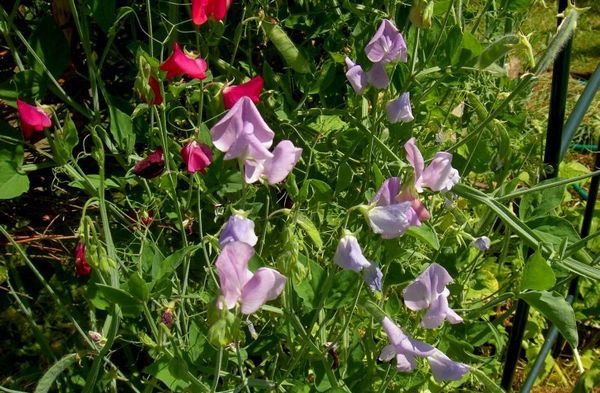

After a couple of days, the root system of the plants will begin to braid with an earthen ball in a glass. After the formation of the first few leaves, you need to remove the top, shoots and apply top dressing.This will allow the plants to bush, which will lead to a build-up of root mass.
To transplant the plant into open ground, try to very carefully pull the seedlings out of the container along with the earthen lump, being careful not to destroy it or damage the roots. The best way to do the work is to carefully cut and remove the plastic cup.
In our material, we will analyze step by step how tomatoes are planted in open ground.
Here you will learn how to grow potatoes under straw and what are the advantages of such planting.
How to plant an apricot and grow it from a stone? You can find out about this here.
Planting seedlings in the ground
We choose a suitable place in the garden, dig it up, not forgetting to add compost or humus. When the seedlings reach 10-15 cm in height, they can be planted on the site. On the site, we prepare holes at a distance of 20-25 cm from each other. Each hole can be planted with 2 or 3 plants. Seedlings must be separated very carefully, and it is desirable that the earthy lumps remain on the roots. As soon as the seedlings are taken in, support should be prepared for them to guide further growth, otherwise they will intertwine with each other.
How to properly care for a plant?
For the first few days, the young seedlings should be shaded after planting using newspapers or paper. Do not worry if, after planting, the plants first stopped in development - they will freeze for a couple of days, and then they will grow. At the same time, a mass of lateral shoots will appear on the seedlings within a week.
After planting the plant in open ground, sweet peas need to be weeded, loosened, and sometimes watered. In addition, you cannot do without creating supports, for example, equip a net or twine. As the shoots grow, they need to be tied up, and in order to simulate the appearance of the shoots of the root system, one cannot do without feeding and hilling.
Another important nuance, which is worth remembering - to prolong flowering, you should remove faded peduncles, otherwise it may end after a couple of weeks. And to get seeds in the next period, you need to leave several pods on the plant.
Sweet peas can be damaged by various diseases, such as root rot or powdery mildew. Pests such as slugs or snails may also appear.
Preparing the soil for planting
Before planting perennial sweet peas, gardeners are advised to prepare a certain soil composition. The area where this culture will grow must be dug up along with organic fertilizers (compost). In addition, add phosphorus and potassium fertility granules to the soil. Nitrogen fertilizers and fresh animal manure are contraindicated for this soil. The surface layer of the soil of the personal plot should have a neutral acidity. Otherwise, when digging, add slaked lime along with fertilizers.
Throughout the growth and flowering of sweet peas, the care of the plant should consist of removing weeds. It is impassable to loosen the ground, periodically apply a certain composition of micronutrient fertilizers for young shoots and water it constantly.
To increase the duration of flowering, it is necessary to cut off the faded peduncles that periodically appear on the stems of this culture. Do not water the soil around the plant abundantly, as there is a danger of infection with powdery mildew or root rot. These fungal diseases lead to the death of the plant.
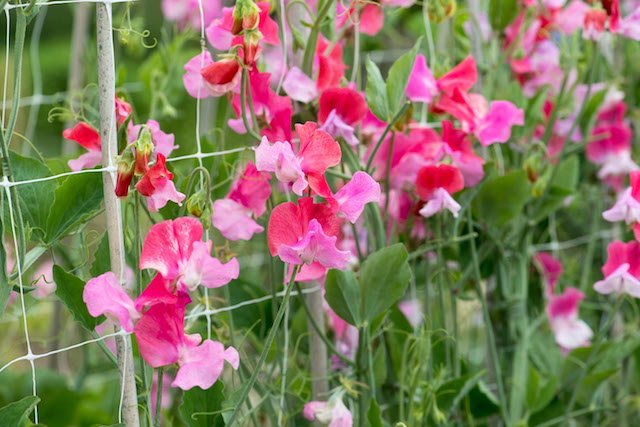

Rules for growing a perennial plant
The seeds of perennial sweet peas, a photo of which are presented below, germinate slowly and for a very long time. There are 2 types of ranks - broad-leaved and large-flowered, which can be planted on a private plot and admire this weaving plant for a long time. Broadleaf has a large mass of leaves and is used in agriculture as a forage crop. Her flowers are faded, dirty pink, and they don't smell. Large-flowered rank refers to decorative weaving plants, blooms profusely with large, odorless pastel flowers.
To get seedlings of perennial ranks, the seeds are soaked in early February and sown in a light nutritious soil under a film to create a greenhouse effect and prevent the soil from drying out. After the emergence of full shoots, the film is removed and the plants are fed with nitrogen for active growth. To do this, take 1 g of nitrate per liter of water and quickly spill the soil so as not to burn the roots. After the formation of 2-3 true leaves, the plant begins to harden and, after the end of the frost, is planted in the ground. Such an early planting makes it possible for the bush in the first year of life to get stronger over the summer and strengthen the root system. During the first season, a poorly growing plant can be watered with a nitrogen solution at the rate of 1 s. l. 10 liters of water.
Perennial sweet peas, which can be planted on the south or west side of the building, love bright light and a lot of moisture. The selected location can be slightly shaded, then the lashes will grow more actively to reach a location that is actively lit by the sun.
For the lashes, good support is needed, therefore, a special wall is created for the garden from any kind of mesh materials so that the lashes of the plant do not crumple and rot.
Lattices of open gazebos, pergolas, verandas and other temporary structures available on the site are suitable as a support. Everything that you want to hide from prying eyes in summer and decorate with light flowers can be hidden under the rank of perennial.
From the perennial rank, one should not expect violent flowering in the first year of life. First, a small bush grows from a pea, and it can be transplanted to a permanent place in late summer or next spring. The plant hibernates well, and, gradually increasing the root system, every year it builds up flowering whips in the summer.
Weeding and loosening the soil
Weed and loosen the ground on which sweet peas are growing should be done with great care. A slight exposure of the roots can lead to wilting of the entire plant. If you don't want to use a hoe, wait for it to rain. It will be much easier to remove weeds on damp ground.
Periodically, the soil needs to be loosened, as the roots need a good supply of fresh air. Sometimes, for planting on heavy soils, the over-row method is used. You can also slightly mulch the soil. This will help you stop the growth of weeds and retain moisture in the soil during dry periods.
The use of ranks in landscape design
Zinnia - growing from seeds at home
Due to its ability to curl and bloom for quite a long time, the rank is most often used for vertical gardening. The most suitable places for her to disembark are:
- walls that need to be given a more picturesque look;
- fences and hedges that the colored peas will turn into living ones;
- the perimeter of the arbors, which it is desirable to shade;
- supports (nets, lattices), which makes it possible to get a blooming green wall.
Low-growing varieties fit perfectly into the landscape when planted along curbs, in flower beds, and in single cut plantings they are very good.
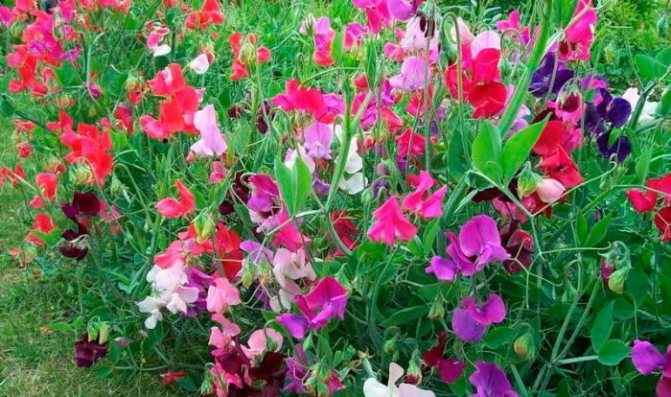

Mass plantings of peas of different colors look especially bright.
White peas
The difference between white peas lies in the light shade of the grain. An annual culture with white inflorescences, has found widespread use in medicine. White pea flour helps to cope with headaches, heartburn, diseases of the genitourinary sphere, heart diseases. White peas are used in cosmetology. The main purpose, undoubtedly, is the use in food, in the form of soups, sauces, side dishes. White peas grow well on sufficiently warm and illuminated loamy soils. The plant is capricious about drought and requires increased root moisture.
Preparing and sowing seeds for seedlings
Seeds ranks
preparation is required before landing. Soak them for 24 hours in hot water (+ 50 + 70 degrees). The ideal time for this is late April - early May.
Important note
: you can only soak brown-brown and gray-brown seeds, and beige and other light beans die with this treatment.
All substandard seeds soon pop up
to the surface. They must be collected and discarded, and the selected full-weight beans must be washed, wrapped in a soft cloth and placed in a humid environment for germination.
Immediately after germination
(this will happen in 2-3 days) the seed is planted in separate containers with nutrient soil, deepening by 2-3 cm. The composition of the soil should be neutral or slightly acidic (a regular substrate for flowers is suitable). For good germination and development, peas need systematic watering, a lot of light and a fairly high air temperature (+ 18 + 20 degrees).
When young shoots
will begin to grow intensively (after the formation of the first 3 leaves), it is recommended to pinch the top to stimulate the growth of lateral shoots and the formation of a lush bush.
Plant peas
in open ground it is possible already in mid-May. Do this carefully - young plants are very fragile and their root system is very weak. Therefore, it is best to carefully transplant them together with a lump of earth or sow them in peat pots in advance.
When to plant sweet peas for seedlings and how to do it correctly?
The method of sowing sweet pea seeds directly into the ground is less likely to bring good results than growing seedlings.
Read also: Propolis with honey: what is useful, what heals, how to make, where to store
When to plant sweet peas for seedlings in 2019 - good days?
Sweet pea seeds for seedlings are usually sown in the third decade of March (from March 21 to March 30). - early April (from 1-10)
According to the lunar calendar, favorable days in March 2019 are: 25, 26, 27, 28
How to plant sweet peas for seedlings?
You need to start planting with the preparation of seeds.
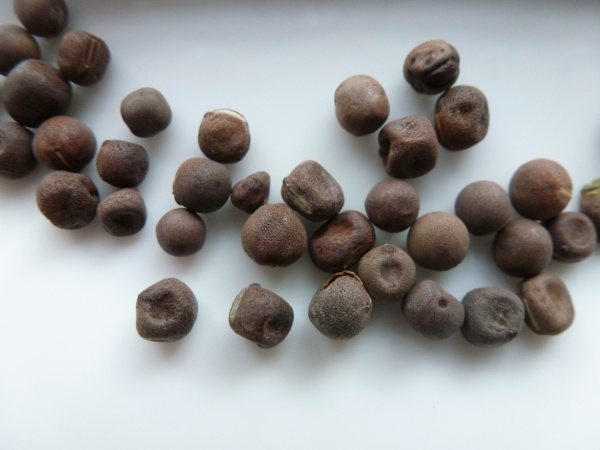

sweet pea seeds
- Preparing seeds for planting
Since the seeds of this plant have a dense structure, it is best to fill them with 50-degree water in a glass before planting and leave for a day. If the seed has risen to the surface, then it can be safely thrown away.
The remaining seeds are washed well and can be prepared for planting.
Next, a handkerchief or gauze is taken, into which you need to pour sand, moisten it and plant seeds there.
Tie the scarf in a knot and leave to germinate the peas.
It is important to keep the sand wet and the ambient temperature should vary between 20-24 degrees.
Also, in order to speed up the maturation of seedlings, it is necessary, after soaking, to select non-swollen seeds and, using a sharp knife, sandpaper or in another way, damage their seed coat without touching the embryo. Please note that this cannot be done with creamy seeds.
- Soil for sowing seeds for seedlings
For sowing seedlings, it is necessary to take a complex soil with neutral acidity (pH 7.0-7.5). Before planting, the soil must be disinfected with a strong solution of potassium permanganate
- Sowing seeds into soil:
- As soon as the seedlings appear, the seeds are planted to a depth of two to three centimeters, one piece in separate pots.
- Seedlings appear in 6-8 days. The growing period for seedlings is 35–40 days. From the moment the seeds germinate to the beginning of color, it will take about 60-90 days. The sooner this happens, the faster the flower will bloom.
- After planting the seeds, the container should be covered with foil and placed on a warm windowsill, pre-watered for germination.
You can use various cups as a planting site, or buy small pots from the store.
For more details on how to do this, see this video.
Important Tips
If you want to achieve long flowering, do not let the seeds ripen: after the flowers dry, carefully cut them off.
To obtain high-quality planting material, the bushes must be prepared in advance.
Leave 9-10 large buds on the plant, remove the rest, then you get selected seeds that can be stored on the bottom shelf in the refrigerator for several years. Plant the peas in a new location every year.
It is better to grow seedlings of ranks in a greenhouse. Due to the lack of light in the apartment, the plants can stretch out and weaken. If possible, plant the beans in peat pots to minimize damage to the plant and root system when planting outdoors.
After soaking, each bean can be gently pierced with a needle in several places or slightly scratched (for better germination). Apply top dressing every 2 weeks throughout the summer season.
If suddenly the peas threw off their buds - most likely this was due to a sharp drop in day and night temperatures. Excessive or insufficient moisture can also cause the buds to drop.
Better planting material is provided by specimens grown from seedlings.
Like all legumes, sweet peas are able to increase soil fertility: its roots react with nodule bacteria, facilitating the absorption of nitrogen from the air. Thus, the plant can provide itself with useful substances, at the same time contributing to the enrichment of the soil after the decomposition of the root system.
So sweet peas will not only cheer up with their bright flowering, but also bring invaluable benefits to the site.
And for those who like to know more, we suggest that you familiarize yourself with the video about scented peas
Field peas
Herbaceous annual plant, sown for use as green manure, fodder and for the use of crops in honey production. The early ripening and unpretentious culture is an excellent help for farmers. Revitalizing the soil, increasing its aeration and moisture capacity, field peas serve as an excellent green manure and have their place in the crop rotation of agricultural crops. It will become the “good” predecessor of winter wheat. Animals are happy to eat peas as a food base, and as an addition to their daily diet.


Conditions for landing
Peas Ambrosia
In order to grow sweet peas, you need to choose the right planting site. The area for plants should be exposed to the sun, but sheltered from the wind. The soil for planting is selected with a neutral PH reaction and good drainage. It is enriched with organic fertilizers.
In the autumn, lime, potash, phosphorus fertilizers are added to the flowerbed and dug to a depth of about 50 cm. And in the spring, before planting by seed or seedlings, the soil is again treated with a hoe.
Growing
Plant annuals in any well-drained but water-intensive soil. China grows poorly in highly shaded areas, and plants fade quickly on south-facing walls and hedges. For clinging forms, support is needed; as it grows, new shoots should be tied up. Pinching the growing tip at the level of the third pair of leaves leads to a significant increase in growth. This should be done with a plant height of about 15 cm.
Regularly remove faded parts to prolong flowering.
Watering is required in dry weather. Perennial species are planted in any good garden soil. L. grandiflorus, L. latifolius and L. vernus can be planted in the shade with a glimpse of the sun or in places that are shaded for part of the day. L. rotundifalius grows best in the shade. For clinging plants, support is required; you can direct their growth to hedges or bushes. Remove dead plant parts to prolong flowering. In the fall, the stems are cut to the ground. L. nervosus should be mulched in mid-fall and protected for the winter by covering them with glass frames or hoods.
Green peas
The plant is an annual, green pods and grains, the main purpose is to eat. Green peas are a kind of storehouse of vitamins and minerals, as well as a concentrator of vegetable protein.Moreover, as the seed matures, the concentration of nutrients and minerals increases. An interesting fact is the content of citric acid in green peas, which exceeds its percentage even in potatoes. Green peas are especially useful raw. Green peas, like other varieties, debug the work of digestion and saturate the body with useful microelements.
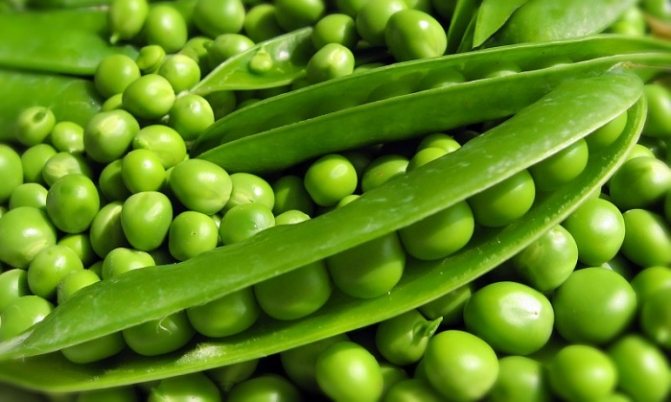

The culture is not whimsical to care for, it grows well on a personal plot in compliance with crop rotation and gives a good harvest, subject to agrotechnical measures aimed at increasing the yield of legumes.
Sowing indoors: basic rules
In order for sweet peas to please with flowering as quickly as possible, you can sow it in protected ground, and then transplant it to a garden bed.
What is needed for sowing sweet peas?
- Quality seeds - self-harvested or purchased. It is important not to skimp on buying seeds and give preference to a reliable company. Hybrid varieties of sweet peas bloom very beautifully.
- Earthen mixture. It is advisable to use purchased land or peat. Sphagnum peat is best suited, since it does not contain stimulants, a large amount of trace elements and has bactericidal properties.
- Potassium permanganate.
- Mini greenhouse or plate with a thick transparent lid.
- Small containers for sowing seeds.
Everyone can cope with the task. It is only necessary to learn the main rules for sowing sweet peas.
Before planting seeds, you need to calibrate them. This means choosing the largest and strongest seeds from which a powerful plant will grow. It is also important to check the percentage of healthy seeds that will sprout. To do this, soak the seed in warm salted water for five minutes. We throw away everything that floats up. For sowing, only those seeds that have sunk to the bottom of the container are suitable.
Sweet pea seeds have a very dense skin. A lot of moisture is needed for the sprout to break through it. But when sowing in a closed container, excess moisture can be detrimental to a young sprout. To avoid wastage, it is best to first germinate the seeds in a humid environment and then plant them in cups.
In order to soften the peel, you can also pour hot water over the peas and leave it there for a day. This procedure not only softens the skin, but also stress the seeds, which serves as a catalyst for the germination process. After that, we place the seeds in a damp cloth and send them to the greenhouse. Now the main thing is not to miss the moment when the peel bursts. To do this, you need to check the seeds in the greenhouse two to three times a day.
Seeds with cracked skin can already be planted in cups with damp soil. It is also advisable to place the cups in a greenhouse or cover them with foil before the first shoots appear. Then you can already lower the temperature and reduce the humidity. Growing young shoots on a windowsill is the best way to keep them from pulling out. It is also important that the temperature does not exceed 20 degrees. During this period, the light regime plays a special role: the more sun and light, the better for a young plant.
Picking peas
Two months after sowing, the first crop can be harvested. If the peas were planted in April, then the pods will ripen in July starting from the lower layer.
Harvest should be done every two days as it ripens. It is necessary to pluck the pods carefully by pinching or cutting them off, making sure that the bush does not break.


How and when to plant sweet peas in 2019 for seedlings?
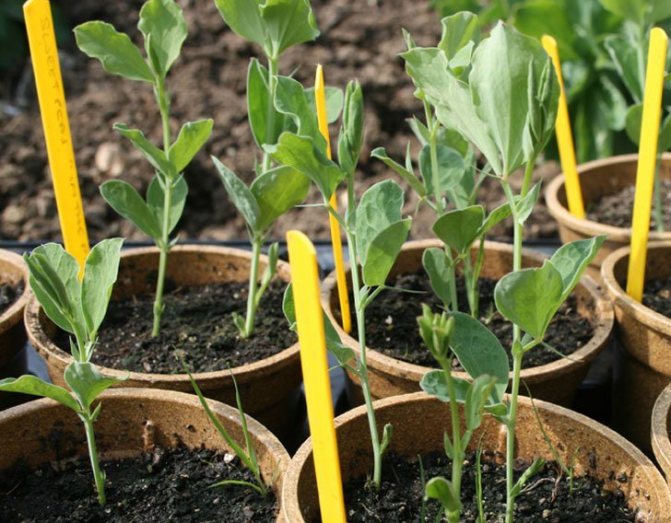

An article about when to plant sweet peas for seedlings in 2019 and how to do it correctly in order to get a beautiful flower bed of fragrant flowers in your country house.
Curly lashes of flowers that look like moths, a huge variety of shades, a delicate aroma and inflorescences that will delight the eye from June to November - these are all sweet peas.
It serves as a decoration not only for fences, arches or gazebos, but also for flower beds.
It adds color and warmth and is easy enough to grow.
Stella, Orient, White Harmeni, Jenny, Janet, Marion, William, Lily Wat Joy, Cream Jigantic, Swan Lake, Burpee Best White.
Peas in Cooking: Food Recipes
Initially, peas were used in cooking only in dried form. It was used to make cereals, soups and flour, from which bread was baked.
In the eighteenth century in France, peas began to be eaten raw immediately after they were ripe. The peas were added to the salad and served as a side dish. With the development of the food industry, it began to be preserved and frozen.
We bring to your attention several simple and delicious recipes for pea dishes.
Peas in a slow cooker without soaking
Peas cooked in a multicooker turns out to be very tasty and aromatic, and the absence of a soaking procedure speeds up the preparation of the dish. Ready-made peas can be served with meat and vegetables.
Ingredients:
- Split peas - 400 grams;
- Hot water - 800 milliliters;
- Butter - 2 tbsp. spoons;
- Salt and pepper to taste;
- Sunflower oil - 2 tbsp spoons;
- Carrots - 1 piece;
- Onions - 1 piece.
Cooking peas:
We take a slow cooker, pour oil into it and put grated carrots and finely chopped onions in it. We pass them in the "frying" mode for fifteen minutes. Stir the vegetables from time to time.
We wash the peas and add them to the vegetables along with hot water, butter and spices.
We set the "porridge" mode and cook for an hour. After cooking, mix the peas and serve. Bon Appetit.


Canned peas
The peas canned according to this recipe turn out to be very tasty and even outperform the store options.
Ingredients:
- Green peas - 1 kilogram;
- Sugar - 1 tbsp. the spoon;
- Water - 1 liter;
- Salt - 1.5 tbsp spoons.
Cooking canned peas:
We take peas, rinse. Boil water and add sugar and salt to it.
Place the peas in boiling water for five minutes.
Then we put it in sterilized jars along with the brine and roll it up.
We remove the finished workpieces in a cool place until they cool completely.
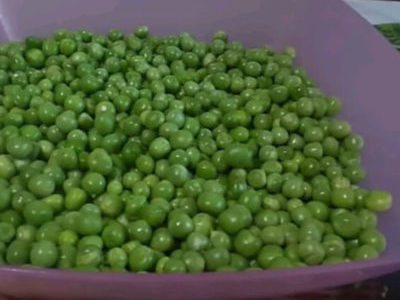

Pea cutlets
Pea cutlets are very tasty, healthy, and most importantly, low-calorie. They can be served with a vegetable salad or as a separate dish with sour cream.
Ingredients:
- Dry peas - 300 grams;
- Salt to taste;
- Onions - 300 grams;
- Flour - 150 grams;
- Eggs - 3 pieces;
- Frying vegetable oil - 6 tbsp. spoons.
Cooking pea cutlets:
We take peas, wash and soak in cold water for several hours. After the time has elapsed, boil it until tender, strain it, pass it through a meat grinder and mix with fried onions, salt, eggs and flour.
We form the resulting mixture in the form of cutlets, roll in flour and fry on both sides until golden brown.
Serve cutlets with sour cream or ketchup. Bon Appetit.


Fresh pea soup
Pea soup will be an excellent first course for those who love legumes and keep fit. It is easy enough to prepare, but at the same time it turns out to be very tasty and nutritious.
Ingredients:
- Green peas - 700 grams;
- Flour - 1 tbsp. the spoon;
- Salt and pepper to taste;
- Ghee - 2 tbsp spoons;
- Eggs - 2 pieces;
- Green onions - 100 grams;
- Tomato paste - 2 tbsp. spoons.
Cooking Pea Soup:
We take ghee and melt in a frying pan and fry the green onions with flour and tomato paste on it.
Then we take a saucepan, pour warm water into it, salt, pepper and set to boil. When it boils, add the peas and cook until tender.
Season the soup with an egg and sprinkle with herbs. Bon Appetit.


Fried peas
Children like this dish very much. It is an unusual alternative to chips. The peas are tasty, aromatic and crunchy. It can be served as a separate delicacy or as a side dish for vegetable salads.
Ingredients:
- Dry peas - 800 grams;
- Vegetable oil - 4 tbsp. spoons;
- Butter - 2 tablespoons spoons;
- Salt and pepper to taste.
Cooking fried peas:
We take peas and soak them overnight in plenty of water. In the morning we rinse and let the water drain. Then we take a frying pan, heat the vegetable oil on it and pour the peas into it. Salt and pepper to taste.
We fry it for fifteen minutes, stirring occasionally. When it begins to harden, add butter to it and fry it for another ten minutes.
After it starts crunching, remove the peas from the stove, transfer to a plate and serve. Bon Appetit.
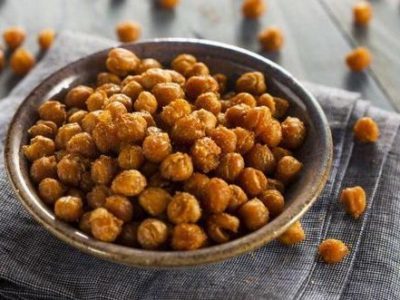

Moonshine on peas
Pea moonshine is practically no different from ordinary. However, it has a softer and more pleasant taste.
Ingredients:
- Dry peas - 1 kilogram;
- Dry yeast - 20 grams;
- Sugar - 2 kilograms;
- Water - 12 liters.
Making moonshine:
We take peas and fill it with two liters of water. We leave it for four hours, then drain the liquid.
We take a saucepan, pour three liters of water into it, pour out the prepared sugar and boil the mixture for five minutes. Cool the finished syrup to twenty-five degrees.
We take the yeast, dilute it and pour it into a fermentation bottle. Then add the peas, syrup and seven liters of water. Make sure that the container is no more than ¾ full, as the fermentation of peas produces a lot of foam.
Next, we install a water seal on the bottle and remove it in a dark and warm place for five days.
After the expiration of the period, the resulting mash should be filtered, after which it will be ready for use. Enjoy your drink.
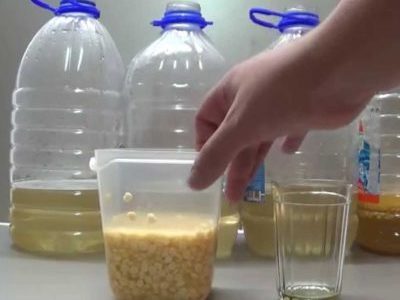

The best types and varieties of scented pot
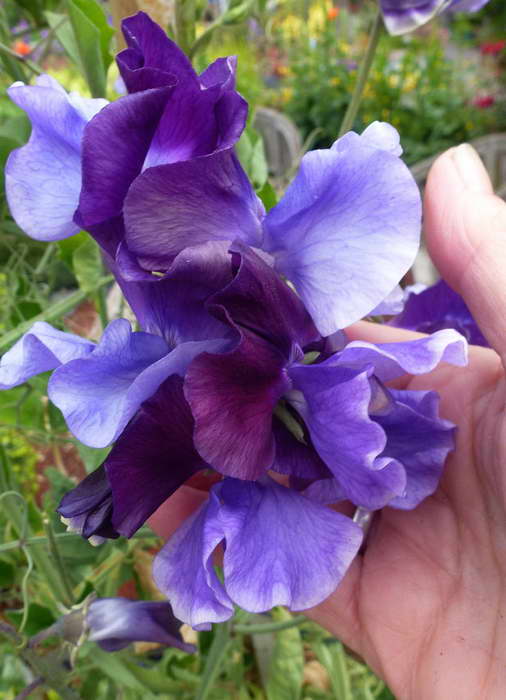

Sweet pea variety Lathyrus odoratus 'North Shore' photo
More than 1 thousand varieties of sweet peas were bred and sorted into several garden groups. Let's consider the most popular ones.
Galaxy Group
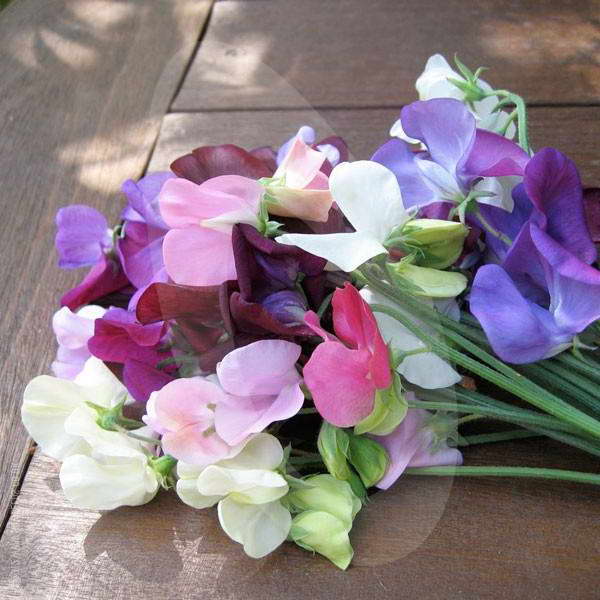

Galaxy Mixed Sweet Peas
The group, bred in 1959, unites late flowering varieties. The height of the bushes reaches more than 2 m. Inflorescences 30-50 cm long bear 5-8 corrugated terry corollas, they are large - 5 cm in diameter. They are inimitable for landscaping the site and are suitable for cutting.
The best varieties:
- Duplex - the plant has very powerful shoots, the inflorescences include 4-5 corollas with a double sail;
- Cream - grows to a height of 0.9 cm. Peduncles are almost straight, 20 cm long, bear 3-4 corollas. They have a folded or double sail, they are 4.5 cm in diameter, a shade of pale cream;
- Neptune is a one and a half meter branched bush with straight peduncles 30 cm long. They have 5-7 corollas 5 cm in diameter. White at the base, then blue, double sail;
- Milky Way - an actively branching bush rises to 1.45 m. The inflorescences consist of 5-6 flowers with a diameter of 5 cm. Fragrant, with a double sail, they have a milky shade.
- Bijou is a group of late-flowering semi-dwarf plants, a merit of American breeders, it was created in 1963. The neat bushes are only 45 cm high and do not need support. Inflorescences 30 cm long, each with 4-5 corrugated flowers with a diameter of 4 cm.
- Spencer is a group filled with multi-stem plants with a height of about 2 m. The flowering time is average. Brushes consist of 4-5 corollas 5 cm in diameter, they are simple or double with wavy edges of the petals. Suitable for garden decoration and for cutting.
Also noteworthy are the varieties:
- Warrier - the peduncle is almost straight. Corollas 4 cm in diameter with smooth oars and wavy sail, dark purple color with white strokes at the base;
- Jumbo - meter bushes with upright powerful inflorescences. Corollas 4 cm in diameter have a salmon-pink hue, the boat is whitish, the sail is slightly wavy, the oars are not very bent. The aroma is weak;
- Charlotte - bushes 1.5 m high have inflorescences 25 cm long. They bear 2-4 bright crimson flowers. 4.5 cm in diameter with a wavy sail and widely spaced oars;
- Cream Dzhigantik - shoots reach a height of 1.75 m, peduncles are straight, about 30 cm long. Spare flowers with a diameter of 4.5 cm are grouped into inflorescences of 3-4 pieces.The shade is cream, slightly bent oars are set wide apart, the sail is wavy.
Do not ignore the following members of the group: Iyer Werden, Garnet, King Lavender, Mahogany, Spencer Monty, Flagship.
Earley Spencer


Sweet peas Earlee Spencer photo
A group of early flowering varieties of sweet peas was bred in 1910 by breeders from America. Bushes with a height of 1.2-1.5 m have inflorescences 35 cm long. Corrugated corollas with a diameter of 4.5 cm are collected in 3-4 pieces.
Cupid


Sweet Pea Cupid Cupid Mix
They are a group of undersized varieties that appeared in 1895. Compact bushes 30 cm high throw out 7-centimeter inflorescences. Small flowers are collected in 2-3 pieces, the color is varied. They do not need support, they grow in pots and on the site.
Cuthbertson-Floribunda


Allspice peas Cuthbertson Floribunda Choice Mix
A group of two-meter early flowering varieties of American origin, bred in 1952. The inflorescences are powerful, 0.4 m long, erect and suitable for cutting. Corrugated flowers with a diameter of 5 cm are collected in 5-6 pieces.
Popular varieties:
- David - a climbing bush 1.4 m high is framed by almost even inflorescences 30 cm long. Fragrant dark crimson flowers 5 cm in diameter are grouped in 5-6 pieces. The sail is wavy, boat with a white brushstroke at the base;
- Kenneth is a bush 1 m high. The sixteen-centimeter inflorescences have 5-6 corollas with a diameter of 4 cm, their sail is slightly corrugated, and the boat is slightly bent;
- White pearl - snow-white mother-of-pearl corollas with a diameter of 4.5 cm are collected in 5-6 pieces closer to the top of the peduncle, its length is about 30 cm.
Also popular are the varieties Zhelanny, William, Robert Blen, Peggy.
Royal Family
The group that appeared in 1964. The heat-resistant varieties included in it are considered to be improved relative to the representatives of the above-described group. Inflorescences 30 cm long bear large terry corollas, the color depends on the variety.


Sweet pea variety Royal Family Mix Lathyrus odoratus photo
Multiflora Gigantea is a group of early flowering varieties bred in 1960 by American breeders. Plants with a height of 2.5 m produce inflorescences 35-50 cm long. Corrugated flowers with a diameter of 5 cm, are collected in 5-12 pieces.
Ruffled
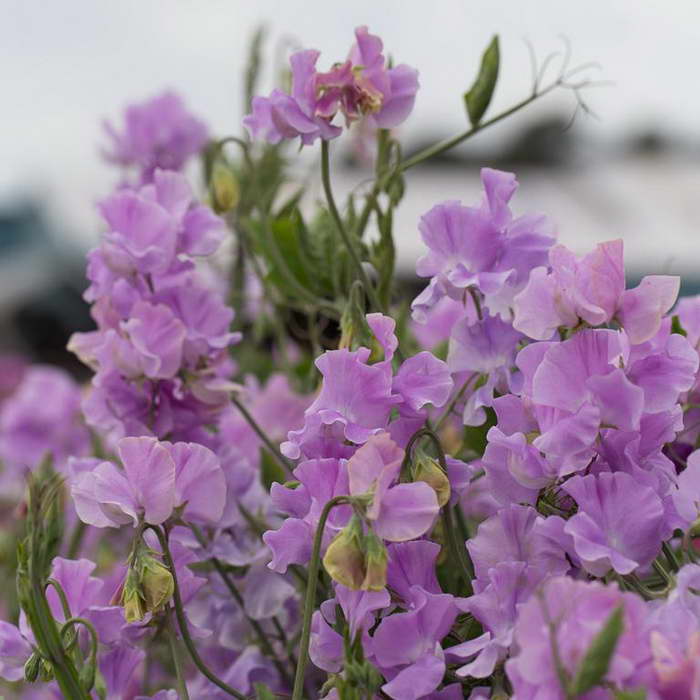

Sweet peas Ethel Grace photo
The group was filled with plants with sturdy stems about 1.5 m long. The inflorescences have 6-10 fragrant flowers with a wavy sail. The corolla diameter is 5 cm.
Varieties:
- Grace is a climbing bush 1.5 m long. An almost erect peduncle stretches 35 cm. It has 5-7 incredibly fragrant lilac flowers with darker veins;
- Ramona - the length of the bush is 1.3 m. The peduncle extends 30 cm and includes 5-6 flowers. Their color is deep crimson, at the base of the boat there is a snow-white tongue.
- Integra, a group that filled the gap between Cupido and Bijou, appeared in 1991. The result of the activities of Russian breeders. These are bushes 35-65 cm high, growing without support. Inflorescences 20 cm long bear 3-4 simple flowers with a diameter of 3 cm. Genina is recognized as the best variety: a compact plant 30-50 cm high with lilac-white flowers.
Lel
An intermediate group regarding Bijou and Multiflora Gigantea, which appeared to the world in 1991. Bushes with a height of 65 cm-1 m. Inflorescences 30 cm long are framed with 7-12 corrugated corollas. They are large, 4.5 cm in diameter.
Features of transplanting to a flower bed
In mid-May, plants can be transferred to a flower bed or garden bed, but before that, they must be prepared for new living conditions.
It is very important that this is just transshipment, and not just planting seedlings. When handling, plants take root in a new location faster and withstand stress better. Such a plant will bloom quickly and will not hurt. He is not afraid of the sun and summer heat, since the root system did not suffer during transplantation and is able to feed the vegetative part.
After transplanting to a flower bed, it is important to shade the plant for the first three to four days so that it gets used to the light and does not burn the delicate leaves.
It doesn't matter what method you use to grow sweet peas, the main thing is to pay maximum attention to the flower, starting from a small grain. If you sow, water, feed the plant in time, it will thank you with bright flowering and wonderful aroma. Growing fragrant peas from seeds is not so difficult if you know all its secrets.
Strange, but sweet peas are considered a rather unpredictable flower among flower growers. Some generally consider him capricious and fickle, although such pessimists want to answer with the words of a famous quote: “You just don't know how to cook it!”. However, to begin with, let's say a few words about the indisputable merits of sweet peas, for which, in fact, all the fuss!
Pea blossom
The legume culture begins to bloom about a month and a half after planting. Inflorescences are small, pinkish, beige, white or purple, located in several pieces. They self-pollinate.
After pollination, pods with beans begin to set. Each pod contains four to ten green peas with a smooth surface.
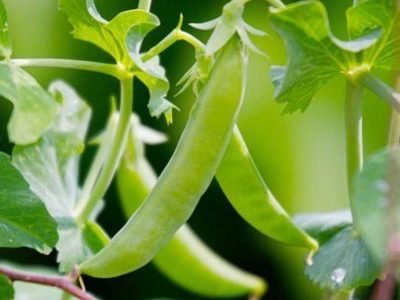

Plant benefits
Sweet peas gained their popularity thanks to their delicate, one might even say fragile flowers and beautiful weaving. In many private houses you can find this particular plant in gazebos, it is not surprising, because the vine has a number of advantages.
This plant is so unpretentious that it is quite possible to grow it on the balcony, and the flower will trail even along the loggia. If you follow normal watering, then a decent plant can grow in ordinary boxes with soil. If we talk about the positive qualities of sweet peas, then it is worth noting the following:
- Excellent decorative properties, liana can create an amazing screen on your site and make a magnificent facade out of a nondescript wall;
- With the help of a vine, you can make a good shadow in the place you need on your site;
- If you have chosen a low-growing variety of sweet peas, then it can be planted in a flower bed without resorting to the help of a support;
- This plant has a faster growth rate than other climbing plants and vines;
- You can admire the flowering for a long period;
- Growing is possible not only in the garden, but also on the balcony;
- After cutting, the plant is stored for a long time, the bouquets stand in vases for a long time.
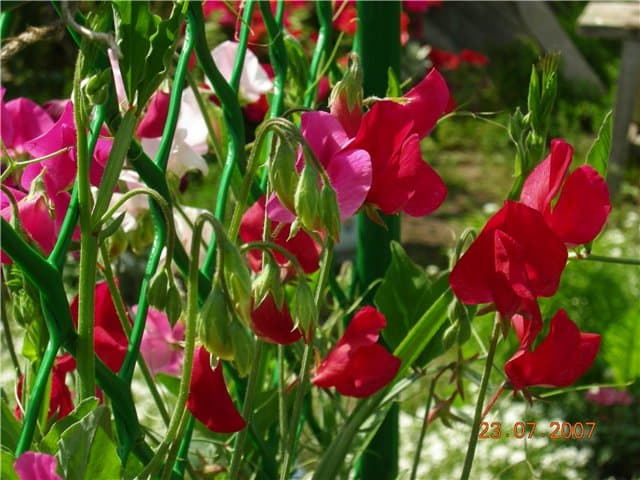

Pea varieties and their characteristics
There are two main groups of peas: shelling peas and sugar peas.
Peeling varieties differ from sugar varieties by the presence of a parchment layer on the inside of the bean valves, which makes them inedible. These peas are grown to produce green peas for canning.
Sugar varieties do not have partitions (parchment layer) and are grown for the sake of immature beans (shoulder blades). Unripe, tender beans whole, without hulling seeds, are eaten. There is also a semi-sugar type of vegetable peas, where the parchment layer is poorly expressed and is noticeable only in dried beans.
Within each of these groups there are varieties with rounded smooth grains and wrinkled grains (brain varieties). The best seeds are brain seeds. They are angular-square in shape with a wrinkled surface and produce sweet, high quality polka dots.
Characteristics of some varieties of peas
Avola 9908469. The pea variety is included in the State Register for the North Caucasus region. Peeling. The pea variety is recommended for fresh use, freezing and canning. Early maturing (56-57 days). The ripening of pea beans is amicable. The stem is simple. The leaf of the common type is green. The pea flower is medium-sized, white. Pods of medium length with 6-9 seeds, green in technical ripeness. The height of attachment of the lower beans of peas is 33-43 cm. The yield of green peas from beans is 45-51%. Fresh and canned peas taste good.
Adagumsky - mid-season variety of canned peas and shelling beans with high taste. The pea plant is semi-dwarf, the stem length is 70-80 cm.Pea beans 6-8 cm long, aligned in color and size. Ripe pea seeds are cerebral, yellow-green in color, overripe - yellow.
Alexandra - a variety of sugar peas for fresh consumption and after cooking. Pea beans have no parchment layer or veins.
Altai Emerald - early maturing (53-55 days) variety of shell peas. Plants are 35-45 cm high. The pea bush is compact. The pea pod is slightly curved. Green peas with a high protein and sugar content.
Ambrosia - a variety of sugar peas. Early ripening, the period from germination to technical ripeness of pea beans is 54-56 days. The height of the stems is 60-70 cm, requires a support or trellis. Young shovels with embryonic seeds are used for food. Seeds of the pea variety are sown in early spring to a depth of 5-6 cm according to the 15x15 cm scheme.
Vega - hulling, medium-sized, medium-early variety of peas. The pods are straight or slightly curved, pointed, 7-9 cm long, contain 6-9 peas. Pea seeds are round, angular, cerebral. The pea variety is used for fresh consumption and canning.
Vera - an early variety of peas. Pea variety for fresh use and processing. The growing season is 48-63 days. Pea stem 55-65 cm high, white flowers, straight or slightly curved pod, 6-8 seed pods, 6-9 cm long, with a strong parchment layer. Pea seeds are wrinkled, yellow-green. The mass of 1000 pea seeds is 180-200 g. The dry matter content is 21.8%, sugar 3.6%, starch 6.7%. The pea variety is susceptible to ascochitosis; it is slightly damaged by the moth. The value of the pea variety is stable yield, amicable ripening, resistance to lodging, suitability for mechanical harvesting.
Viola - a mid-season variety of canned peas with shelling beans. Ripens in 57-62 days. Peas taste good when fresh and canned. The plant is semi-dwarf, the stem length is 60-80 cm. Pea pods with a highly developed parchment layer, straight, obtuse. The peas are even in size, the mature seeds are cerebral, gray-green in color. The pea pod is straight, blunt-pointed, 6-8 cm long, in the pod there are 6-9 grains.
Sunrise - medium late variety of canned peas and with shelling beans. The pea plant is semi-dwarf, the stem length is 65-75 cm. Pea pods with a strongly developed parchment layer, slightly curved, with a pointed tip. Ripe pea seeds are cerebral, gray-green in color.
Giant - a variety of sugar peas. High sugar pods! Pea plant 90-96 cm high. It begins to bloom at the 16th node, 1-2 pods appear from one node. Pea pods are up to 2.8 cm wide and up to 13 cm long. Unusually large pea pods, dark green, soft, tend to take on the shape of a cup when ripe. Pea seeds are large, dark green and wrinkled, usually 8 seeds per pod.
Horn. Pea stem is simple, 60-70 cm long, weakly branching. Up to the first inflorescence 18-22 knots. The pea pod is straight, spiky, medium-sized, green, 7-9 cm long. Green peas are leveled in size, medium-sized, contain 21.5-22.1% dry matter, 5.5-6% sugars, 3% starch. Weight 1000 seeds. peas 170-176 g. Output of green peas 48-49%. The pea variety is resistant to root rot and downy mildew. Designed for canning. Zoned in Moldova, RF.
Emerald - mid-season variety of shelling peas. The stem is simple, 68-85 cm long. Up to the first inflorescence 11-13 nodes, but only 18-22. Pea flowers are white, there are 1-2 of them on the peduncle. The pea pod is slightly curved, pointed, large, there are 5-9 pods on the plant, 10-12 seeds in the pod. Green peas are dark green, contain 20.9-22.5% dry matter, 6.25% sugars, 2.48 starch. Pea seeds are small, light green. Weight 1000 seeds. peas 180-200 g. Output of green peas 49.5-51.9%. The pea variety is resistant to root rot and downy mildew. Intended for fresh consumption and canning. Zoned in Moldova.
Zhegalova 112 - mid-season pea variety, sugar, ripening amicably, eaten in the phase of milk ripeness. The pea stem is simple, long (120-180 cm), needs support. Pea pods are straight or slightly curved, with a blunt top, 10-15 cm long, with 5-7 grains. The yield of the pea variety is high. The harvesting period of pea pods lasts 15-20 days. Pea pod shells are thickened, beans are fleshy, tasty and nutritious. The pea variety was bred at the Gribovskaya vegetable selection station 70 years ago.
Superb 240 - a shelling, mid-ripening, medium-sized variety of peas. Pea beans, curved with a pointed tip, 8-9 cm long, contain 6-9 seeds. Pea seeds are cerebral, angularly square, compressed perpendicular to the scar, yellowish-green. The pea variety is suitable for fresh use and canning.
Premium - an early ripe variety of shelling peas. The period from germination to the beginning of harvest is 55-60 days. The height of the pea plant is up to 80 cm. The pea pod is medium-curved, with a blunt top, 8 cm long, dark green. The plant has up to 14 pods. There are up to 9 green grains in a pea pod. Fresh and processed peas have excellent taste qualities. Used fresh, for freezing and preserving.
Early 301 - an early ripe variety of canned peas and shelling beans with high taste. Ripens in 50-55 days. The stem of the pea plant is short, 35-40 cm long. The pea pods are 8-10 cm long, straight or slightly curved with a pointed tip. Ripe pea seeds are cerebral, yellow-green.
Early mushroom 11 - early ripe pea variety (51-64 days). The plant is 40-70 cm high. The pea pod is large, dark green, 7-10 cm long, straight with 6-10 grains. Green peas are large, tender and sweet, high in vitamin C and protein. The pea variety is suitable for all types of processing. Seeds of peas are cerebral, gray-green.
Sugar-2 - mid-season pea variety. The stem of the pea plant is simple, medium-sized (70-80 cm). Sugar pea pod without parchment layer, 7-9 cm long, 7-9 seeds in a pod. Pea seeds are green cerebral. The pea variety is valued for the excellent quality of the beans, their good grain content, and resistance to lodging.
Soyuz-10 - mid-ripening, amicably ripening variety of shelling peas. The stem of the pea plant is simple, 60-80 cm long. Up to the first inflorescence 12-16 nodes. Pea pod is straight, narrow, blunt-pointed, green, 6-8 cm long. There are 6-7 pods on the plant, 4-10 seeds in a pod. Green peas are dark green, lined, medium in size. contains 21.6% solids, 6.8% sugars, 3.5% starch. Seeds of peas are semi-cerebral, angular-square, wrinkled, yellow-gray-green. Weight 1000 seeds. peas 180-220 g. The yield of green peas is 46-50%. The pea variety is moderately resistant to root rot. Designed for canning. Zoned in Moldova.
Sphere - an early variety of shelling peas. The stem of the pea plant is simple, 65-75 cm long. There are 7-9 nodes before the first inflorescence, and only 11-15. Pea flowers are white, there are 1-2 of them on the peduncle. The pea pod is straight, large, with a sharp slightly curved apex, dark green, 6-10 cm long, 1.3-1.6 cm wide.Green peas, even in color and size, with good technological qualities, contains 17.7 % solids, 5% sugars, 2.1-2.7 starch. The duration of the technical ripeness of the pea variety is 5-6 days. Pea seeds are semi-cerebral, round, medium, yellow-green. Weight 1000 seeds. peas 210-220 g. The pea variety is moderately resistant to root rot. Intended for fresh consumption and canning. Zoned in Moldova.
Tiras - mid-early variety of shelling peas. The stem of the pea plant is simple, weakly branching, 65-80 cm long. Up to the first inflorescence there are 8-10 nodes, but only 11-15. Pea flowers are white, on the peduncle there are 2 of them. Pea pod is curved, large, pointed, dark green, 6-10 cm long, each plant has 6-12 pods, 8-10 seeds in a pod.Green peas are dark green, medium in size, contain 19.5-20.5% dry matter, 5.8-6.5% sugars, 1.7-2.3 starch, 2.7% protein. Pea seeds are angular-square, medium, light yellow. Weight 1000 seeds. peas 220-230 g. The pea variety is moderately resistant to root rot. Peas are intended for fresh consumption, freezing and canning.
Troika - a late-ripening variety of shell peas, ripens in 80-90 days. Medium-sized pea variety - 70-80 cm. Pea pod 6-8 cm long with a sharp tip. The pods are located 2-3 in the fruiting in the upper part of the stem, in the pod of 6-8 pea seeds. Seeds are brain, small, green. The pea variety is good for canning and fresh.
Hawa pearls - a pea variety for fresh use and processing. The growing season of the pea variety is 54-70 days, the ripening of the beans is friendly. The stem of a pea plant is 78-97 cm high, dark green with a waxy bloom. The pea pod is slightly curved, 7-8 cm long, 5-9 seeds. The number of pods on a pea plant is 8-16. The height of attachment of the lower pod is 22-38 cm. The seeds of peas are wrinkled, yellow-green. The mass of 1000 pea seeds is 200-218 g. The peas are dark green, leveled in size, the yield is 39-52%. The taste is great. The dry matter content is 21.5%, sugar 3.2%, protein 6, starch 5.6%. The pea variety is moderately resistant to root rot. The value of the pea variety is high productivity and quality of peas.
Yuzhny-47 - an early variety of shelling peas. The stem of the pea plant is simple, 70-85 cm long. Up to the first inflorescence 8-10 nodes, and only 11-15. Pea flowers are white, on a peduncle of 2. Pea pod is straight with a blunt top, dark green. There are 7-8 pods on a plant, 7-9 pea seeds in a pod. The pods are located at a height of 40-43 cm, compact, ripen at the same time. Green peas in the phase of technical ripeness are green, large, leveled, contains 20.1% dry matter, 5.9% sugars, 2.1 - starch. Pea seeds are semi-cerebral, round, medium, light green. Weight 1000 seeds. peas 235-248 g. Pod yield - 12.8-14, seeds 2-2.5 t / ha. The pea variety is moderately resistant to root rot. Peas are intended for fresh consumption, freezing and canning. Zoned in the Russian Federation.
Era - mid-late variety of shelling peas. The stem of the pea plant is simple, weakly branching. Up to the first inflorescence 16-19 knots. Pea flowers are white, there are 1-2 of them on the peduncle. Pea pod slightly curved, with a sharp tip, bright green, 7-9 cm long, 5-8 pods on a plant, 7-10 pea seeds in a pod. Green peas contain 20.2-21.8% dry matter, 6-7.5% sugars, 2.5-2.7 starch. Pea seeds are medium in size, gray-green, in the form of a drum. Weight 1000 seeds. peas 175-185 g. The pea variety is moderately resistant to downy mildew. Peas are intended for fresh consumption and canning. Zoned in Moldova, RF.
Pests
The most dangerous are root weevils and aphids. Weevils do special harm at the beginning of the development of sweet peas. It is easy to determine the presence of a pest by the nibbled leaves and larvae that have settled on the roots. This makes the flowers look lethargic and grow poorly. To prevent pests from attacking sweet peas, during planting, each hole must be treated with a 1% Chlorophos solution. During the growing season, this agent is used for spraying on the leaves.
The species of aphids that can infect a flower are most dangerous:
- legume;
- rank;
- pea.
Despite their microscopic size, these insects are able to suck juices and infect the plant with diseases. Preparations Cyber, Tsiram - an excellent tool for the prevention and destruction of pests. Spraying is carried out after three weeks.
Peas mung
Also known as mung beans. These peas are very popular in the cuisine of Southeast Asia, they are loved in India, Pakistan. The grains have a light nutty aroma, a pleasant "herbal" taste. They do not need to be soaked; cooking takes no more than 40 minutes. The protein content is quite high - about 24%. The peas are small, oval in shape. They are eaten raw, sprouted, and cooked.


Mung bean peas are practically unknown in Russia, but this crop deserves close attention of gardeners.
The starch is extracted from mung bean peas, which is used to make special "glass" noodles, known in China as "fensi", and throughout the rest of the world - called "funchose".


Peas mung bean - raw material for the preparation of Chinese "glass" noodles, which in Russia are often sold as rice
For Russia, the culture is still very unusual and exotic, so there are no varieties of domestic selection. Therefore, those who grow mung bean peas identify it by the color of the grains - black, white, yellow, green.
Video: what peas mung look like
Peas in a dream
A dream about peas often portends wealth and prosperity. Collecting peas in a dream means that you will soon receive material benefits. Seeing a dry roller coaster to success in business. There are green peas in your dream to climb the career ladder, and boiled peas, to gastrointestinal diseases.
Collect peas for profit. Seeing spoiled peas is a nuisance. Selling peas to bankruptcy.
Even if a dream about peas portends something unpleasant, one should not blindly believe in the interpretation. Each person can change their destiny in accordance with their desires, therefore, a possible negative should be perceived as a warning from above, and not as an inevitable fate.
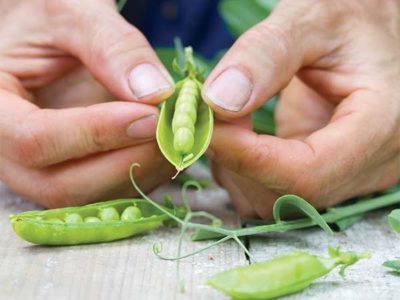

Peas composition: vitamins and calories
The calorie content of peas depends on the variety, storage conditions and pre-processing. The lowest energy value is observed in barely ripe brain varieties - only 42 kcal per 100 grams. Canned peas contain 55 kcal, and frozen peas - 73. The most nutritious are the dried fruits of the plant: the calorie content, depending on the type of crop, ranges from 298 to 323 kcal. The increase in the nutritional value of peas during storage is explained by the formation and subsequent accumulation of sugary substances. The energy value of ready-made meals (soups, cereals, mashed potatoes) depends on their density and the type of product used.
Pea fruit is a rich source of easily digestible protein, which is similar in properties to the protein found in meat. This is due to the presence of such essential amino acids as lysine, tryptophan, methionine. In terms of the percentage of proteins, peas surpass almost all known vegetable crops.
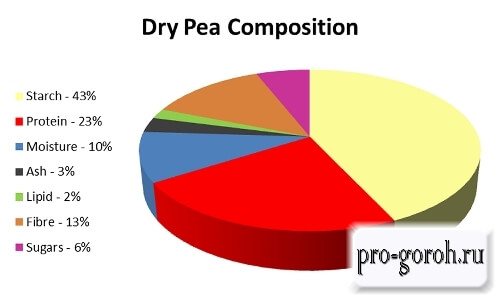

Peas contain more than 10% of dietary fiber. Plant fiber performs several important functions at once: it binds and removes toxins from the intestines, is food for beneficial microflora, provides a feeling of fullness and improves blood composition.
Peas also contain a variety of vitamins:
- retinol (vitamin A) provides growth and rapid tissue regeneration, normalizes the endocrine system, improves the condition of the skin;
- β-carotene (provitamin A) is necessary to strengthen tooth and bone enamel, restore vision;
- ascorbic acid (vitamin C) increases immunity, improves the functioning of the nervous system and protects tissues from free radicals;
- B vitamins (thiamine, riboflavin, pyridoxine, folacin) have a positive effect on the work of some glands, slow down the aging process of tissues.
Nutritionists pay attention to the unique composition of peas: vitamins and calories contained in fruits are able to provide the body with many important biologically active substances and energy necessary for the implementation of vital processes. In addition, peas contain many macro and microelements, including quite rare ones. Among them there are more than two dozen minerals zinc, iron, potassium, cobalt, nickel, vanadium, fluorine, selenium.
Planting methods
Sweet peas are a decoration of any flower bed and flower bed. Its peculiarity is that it pleases with flowering even when other plants are languishing in the summer heat.Sweet pea inflorescences last for more than five months, and the variety of their shades creates a multi-colored waterfall on the flower bed. In the evening, before a thunderstorm, the extraordinary aroma of the plant will not leave anyone indifferent. The flower is also popular for the reason that it feels great both in the sun and in the shade, it is easy to shape and is an excellent arched plant that twists on any support.
There are several ways to plant sweet pea seeds:
- before winter (after the first frost);
- spring sowing;
- into closed soil.
Which of the ways to choose, everyone decides for himself, but it is best to try each of them and give preference to the one that will provide a beautiful and rich flowering.
Black peas
An interesting and unusual bean product. A bare stem, branched long rhizomes of the plant and black seeds are the hallmarks of black peas. The inflorescences of the culture are shaded with purple, burgundy or dark blue shades. The plant blooms at the end of May, and the harvest is already in July - August. Black peas have several types of grains: cerebral and smooth. It is most often found in European countries and is eaten as a side dish and edible decoration for ready-made meals.
Winter and spring sowing
Before winter, sowing is carried out after the onset of the first frost, but the garden bed is prepared two to three weeks before that. The soil is carefully dug up, leveled, weed roots are removed and loosened.
Before sowing, shallow (up to 5 cm) pits or rows are made and seeds are thrown into them. The distance between the peas is 2-3 centimeters. The sown rows are covered with earth and compacted with a shovel. Plants sown before winter sprout in the same period as during spring sowing, but they are resistant to frost and stress, and are distinguished by abundant flowering.
When sowing in spring, the appearance of young shoots has to wait a long time, if you do not cover the planting site with a film or allow the soil to dry out.
Sweet pea is a climbing plant. It is usually planted near fences, gazebos, or under trees. In most cases, sowing is carried out according to the principle: the main thing is to throw it into the soil, and in the spring the stump will bloom. This is the biggest mistake of florists: growing even the simplest plants requires love and patience.
Sweet peas need special conditions for fast germination:
- constantly wet soil;
- heat - about 20 degrees.
Only under these conditions will the tender sprout be able to break through the thick peel of the seed. As a rule, the first shoots appear in mid-May, and the plant blooms in June and pleases with its beauty until October, and sometimes until November.
Top dressing
Sweet peas are fed three times per season:
- Produced when the stems are growing back. Nitrophoska and urea in equal amounts (1 tbsp each) are diluted in 10 liters of warm water.
- It is carried out starting from the appearance of the first flowers. In a bucket with a volume of 10 liters, a tablespoon of potassium sulfate and fertilizer "Agricola - 7" are diluted.
- It is carried out during the flowering period. To do this, a tablespoon of Rossa and Agricocola for flowering plants is dissolved in 10 liters of water. The mixture is consumed in the amount of 3-4 liters / 1m2.
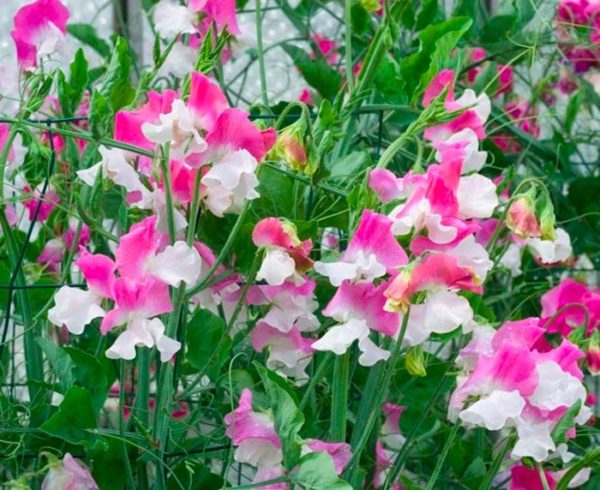

The plant is watered no more than 1 time a week, but there should be a lot of water, 30 liters / m2. The most important thing is to know the "golden mean", not to pour or overdry the peas, he loves abundant watering, but absolutely does not tolerate waterlogging of the soil. During the season, it is recommended to loosen and weed the weeds around the plant at least 3-4 times.


You may be interested in:
Growing fragrant tobacco from seeds Despite the rather provocative name of this plant, we are talking about beautiful small flowers, which many ... Read more ...
Seed peas
One of the most common species used as forage crops and green manure. Sowing peas are subdivided into several categories: shelling and sugar peas.The plant is grown in many countries for the purpose of obtaining feed with a high protein content. The root system is developed in the form of a rod, the stem is thin, reaching a height of two meters. The flowers are self-pollinating, like all varieties of the family. Pea seeds can be quite large and small due to lack of fertilizer.
Top dressing of peas
If at the stage of breaking the garden bed the gardener correctly fertilizes the soil, then during the growth process the fertilization will be minimal. The only time you need to feed the peas is at the beginning of flowering.
For this purpose, a complex water-soluble top dressing should be used in the amount of twenty grams per square meter of the plot. Then the pea root system will independently produce nutrients and fertilizers are no longer needed.
